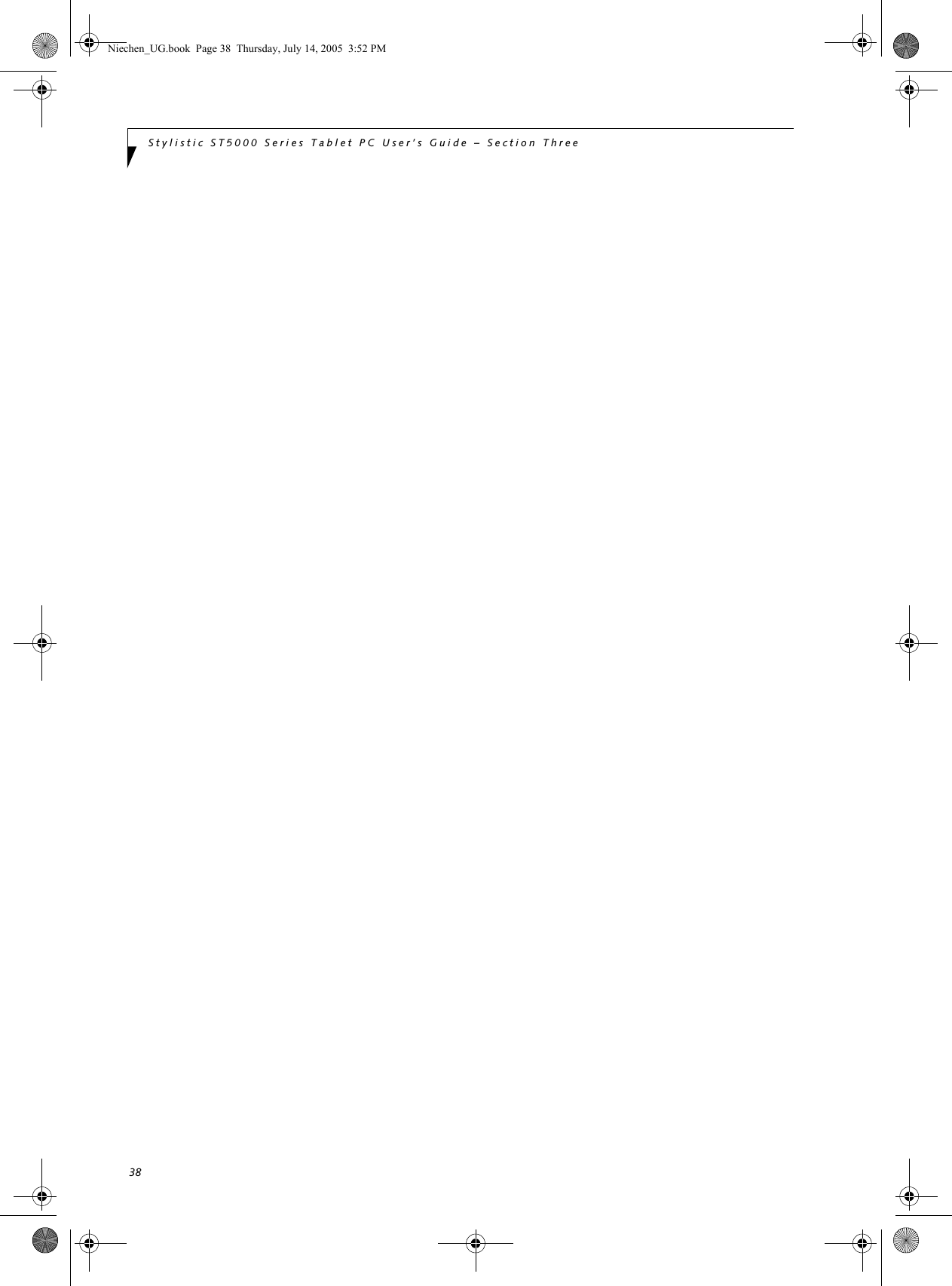Fujitsu Client Computing WB0043 Stylistic ST Series with AR5BXB6 WLAN & Bluetooth User Manual App I1 part 1
Fujitsu Limited Stylistic ST Series with AR5BXB6 WLAN & Bluetooth App I1 part 1
Contents
- 1. App I1 user manual part 1
- 2. App I2 user manual part 2
- 3. Appendix I1 revised user manual part 1
- 4. Appendix I2 revised user manual part 2
App I1 user manual part 1
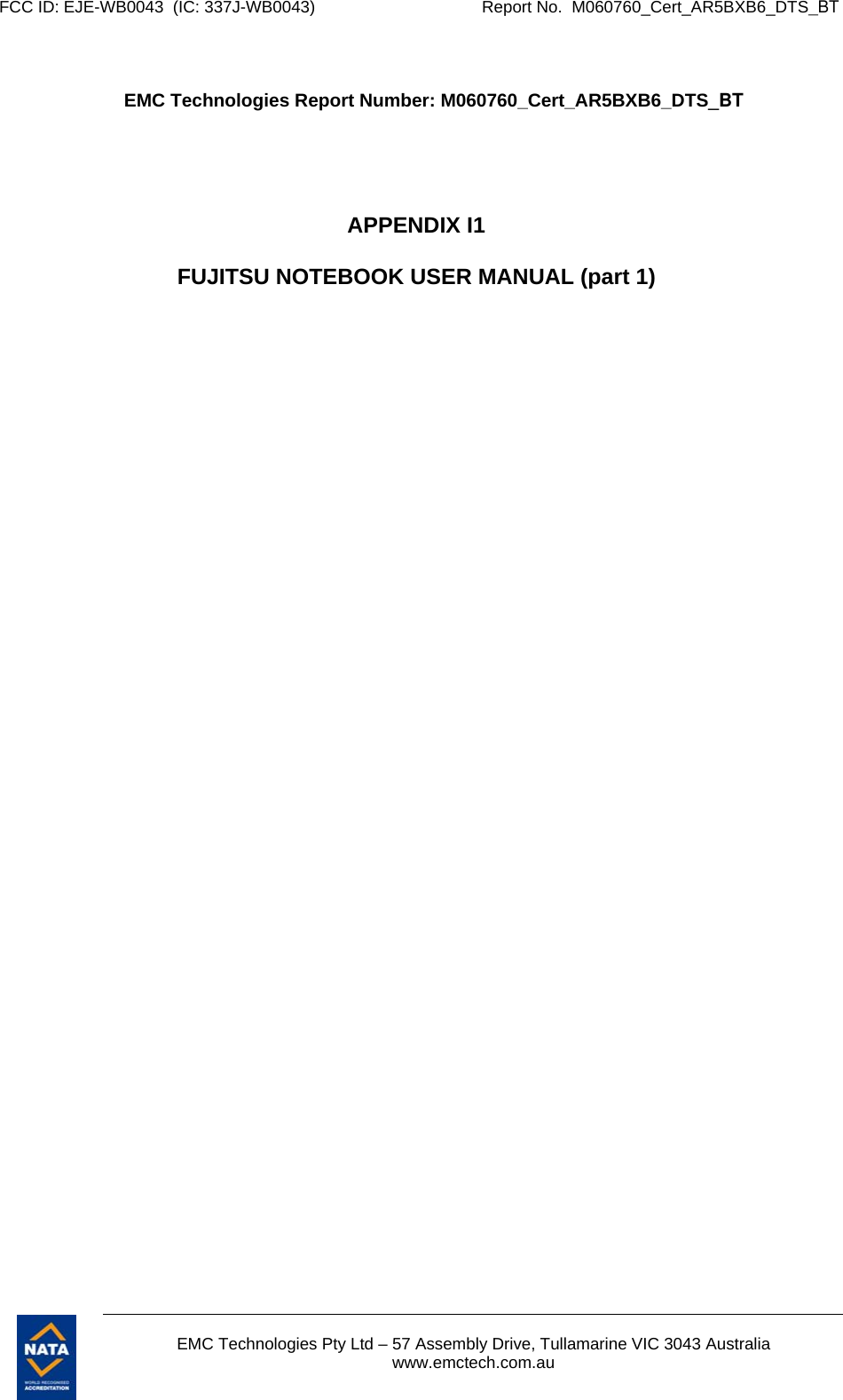
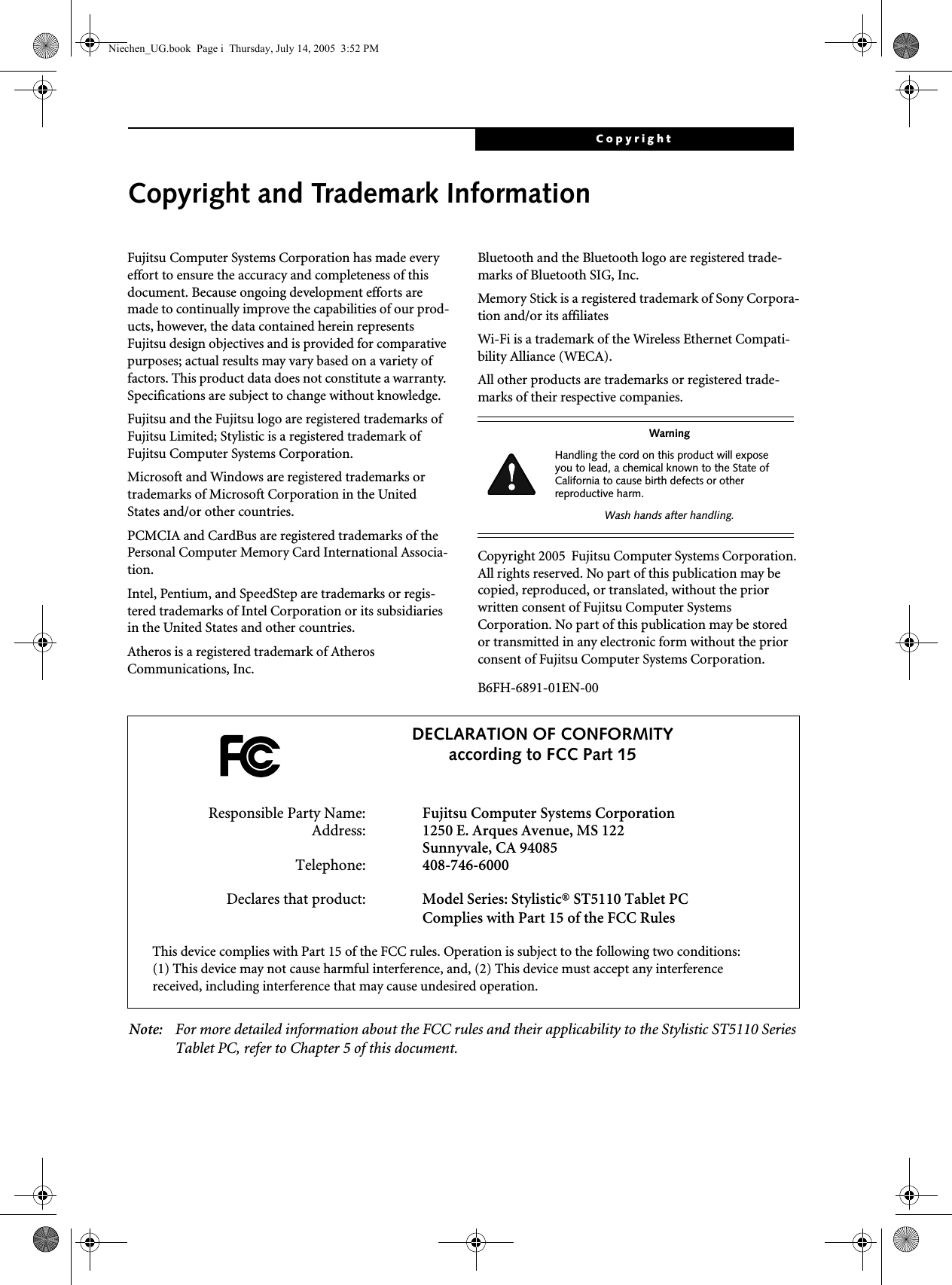
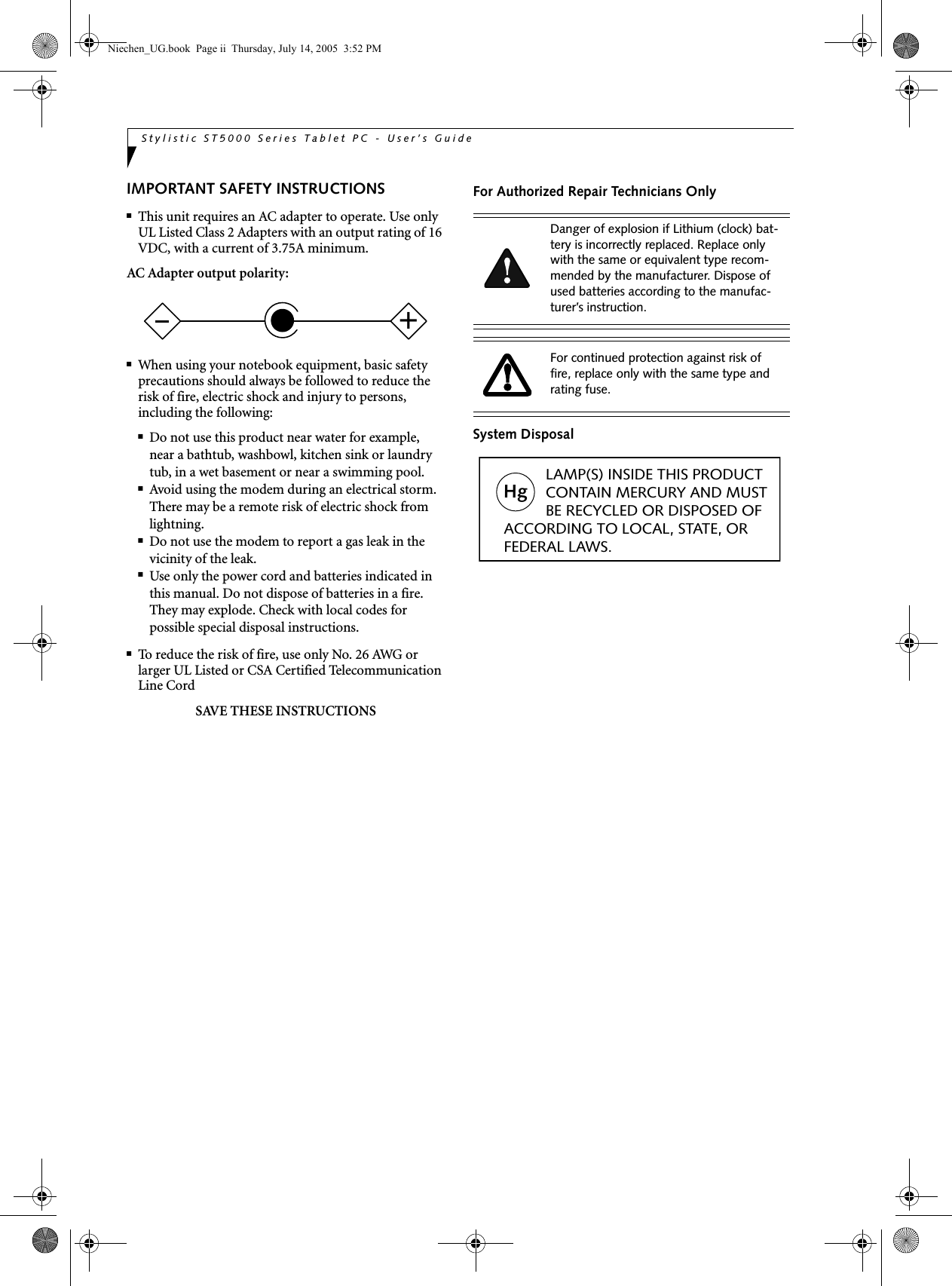
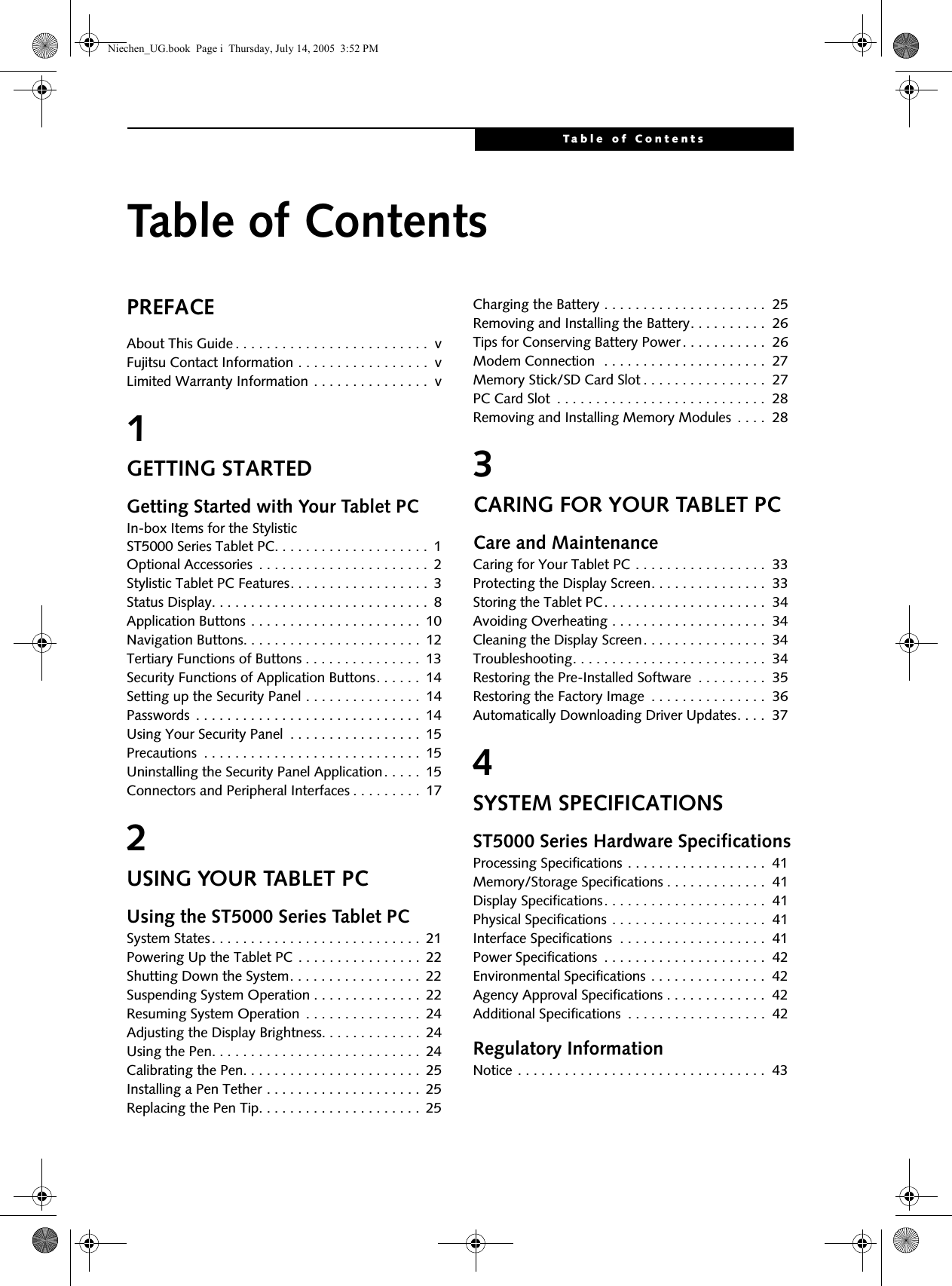
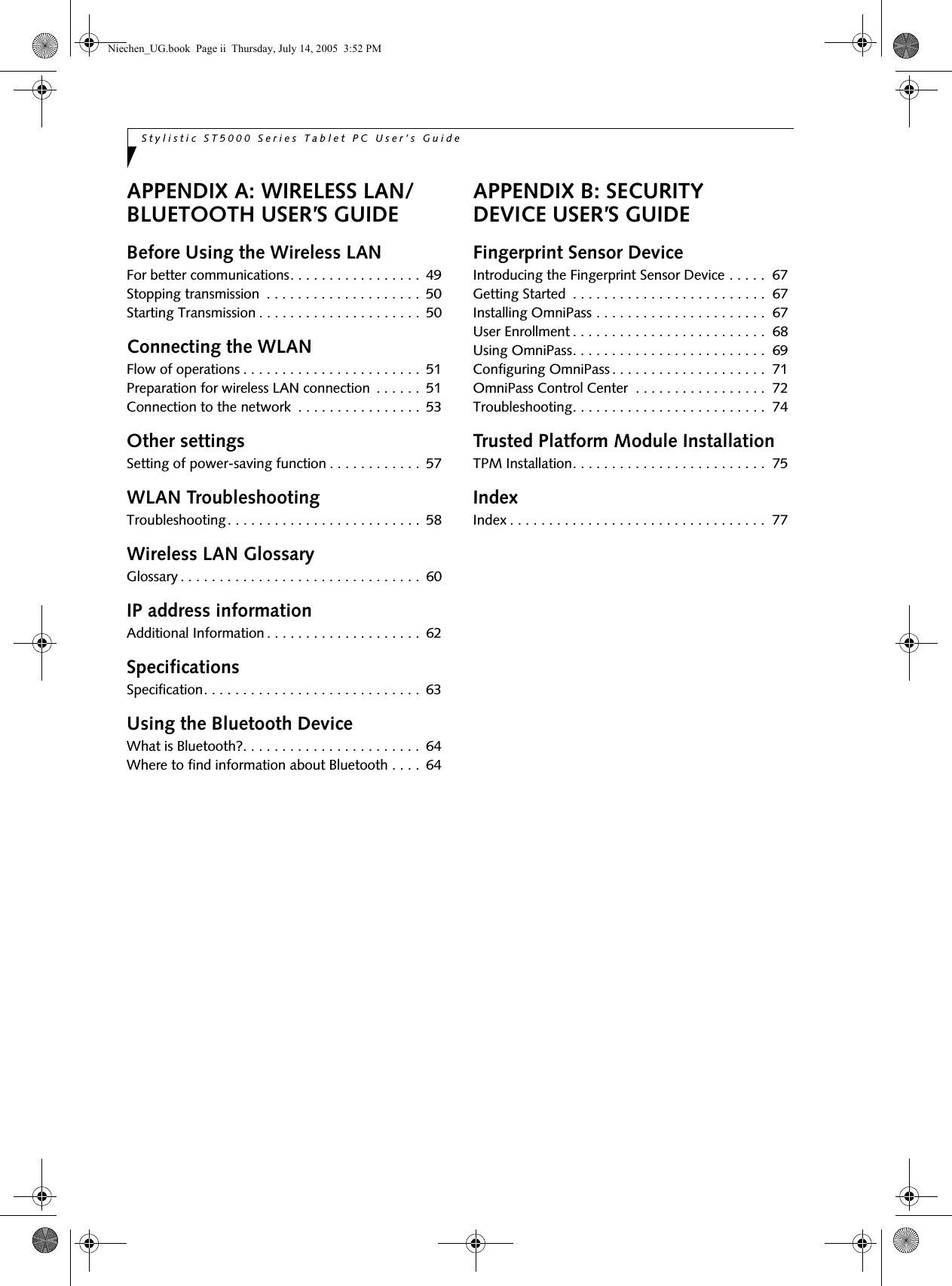

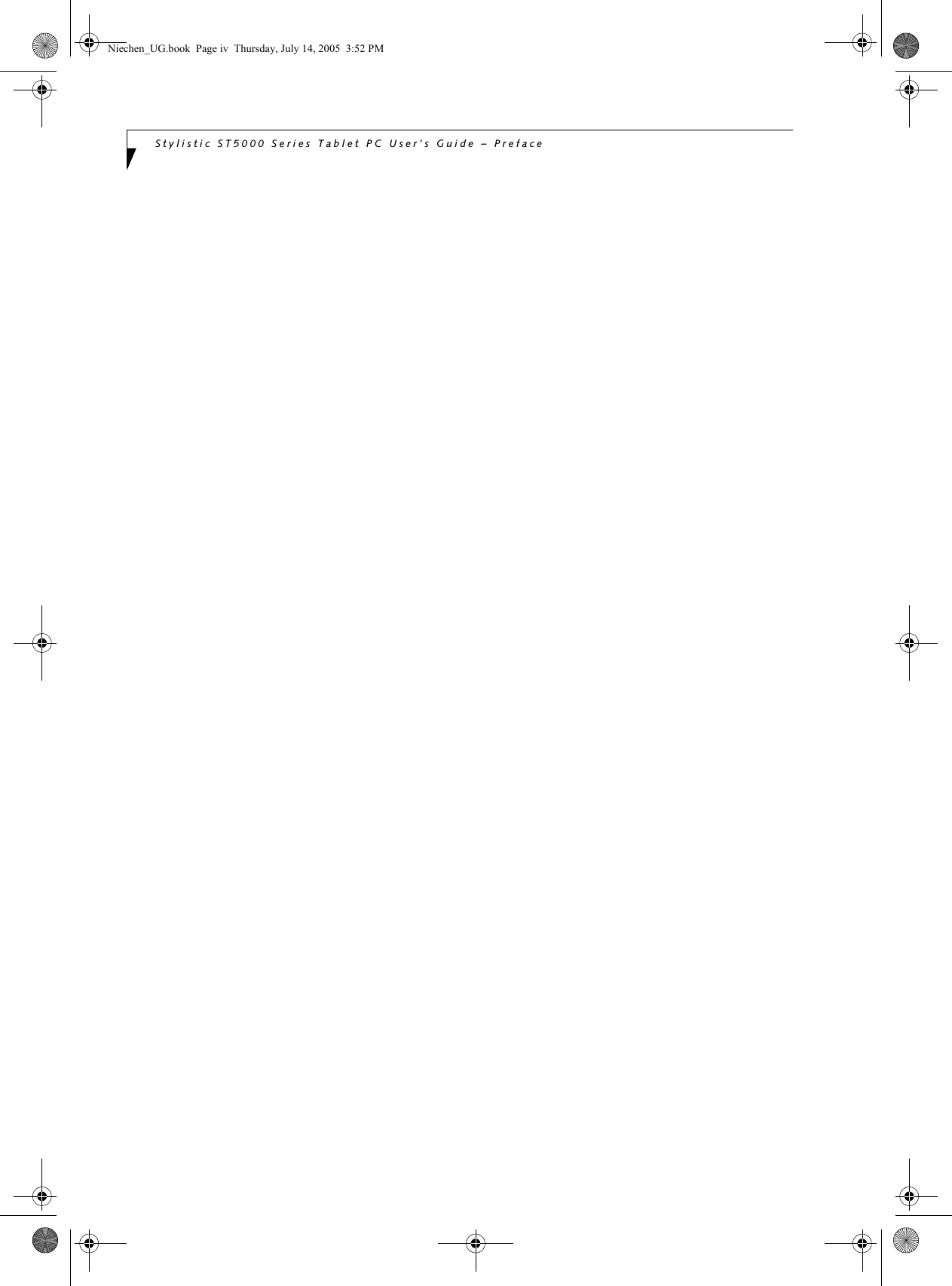
![PrefacePrefaceABOUT THIS GUIDEThe Stylistic® ST5000 Series Tablet PC is a high-performance, pen-based computer that has been designed to support Microsoft®Windows® XP Tablet PC Edition.This manual explains how to operate your Fujitsu Stylistic ST5000 Series Tablet PC hardware and built-in system software. The Stylistic ST5000 Series Tablet PC is a completely self-contained unit with an active-matrix (TFT) color LCD display and an active digitizer. It has a powerful interface that enables it to support a variety of optional features. Conventions Used in the GuideKeyboard keys appear in brackets. Example: [Fn], [F1], [ESC], [ENTER] and [CTRL].Pages with additional information about a specific topic are cross-referenced within the text.Example: (See page xx.)On screen buttons or menu items appear in boldExample: Click OK to restart your Tablet PC.DOS commands you enter appear in Courier type. Example: Shut down the computer?FUJITSU CONTACT INFORMATIONService and SupportYou can contact Fujitsu Service and Support in the following ways:■Toll free: 1-800-8Fujitsu (1-800-838-5487)■E-mail: 8fujitsu@us.fujitsu.com■Web site: http://www.computers.us.fujitsu.com/supportBefore you place the call, you should have the following information ready so the customer support representative can provide you with the fastest possible solution:■Product name■Product configuration number■Product serial number■Purchase date■Conditions under which the problem occurred■Any error messages that have occurred■Type of device connected, if anyFujitsu OnlineYou can go directly to the online Fujitsu product catalog for your Stylistic Tablet PC by clicking on the Fujitsu Weblinks -> LifeBook Accessories web site link, located in the Windows Start -> All Programs menu.You can also reach Fujitsu Service and Support on-line by clicking on the Fujitsu Weblinks -> Fujitsu Service and Support Web site link, located in the Service and Support Software folder of the Windows Start -> All Programs menu..LIMITED WARRANTY INFORMATIONYour Stylistic ST5000 Series Tablet PC is backed by an International Limited Warranty. Check the service kit that came with your system for warranty terms and conditions.The information icon highlights information that will enhance your understanding of the subject material.The caution icon highlights information that is important to the safe operation of your computer, or to the integrity of your files. Please read all caution information carefully.The warning icon highlights information that can be hazardous to either you, your computer, or your files. Please read all warning information carefully.You must have an active internet connec-tion to use the online URL links.Niechen_UG.book Page v Thursday, July 14, 2005 3:52 PM](https://usermanual.wiki/Fujitsu-Client-Computing/WB0043.App-I1-user-manual-part-1/User-Guide-697892-Page-8.png)
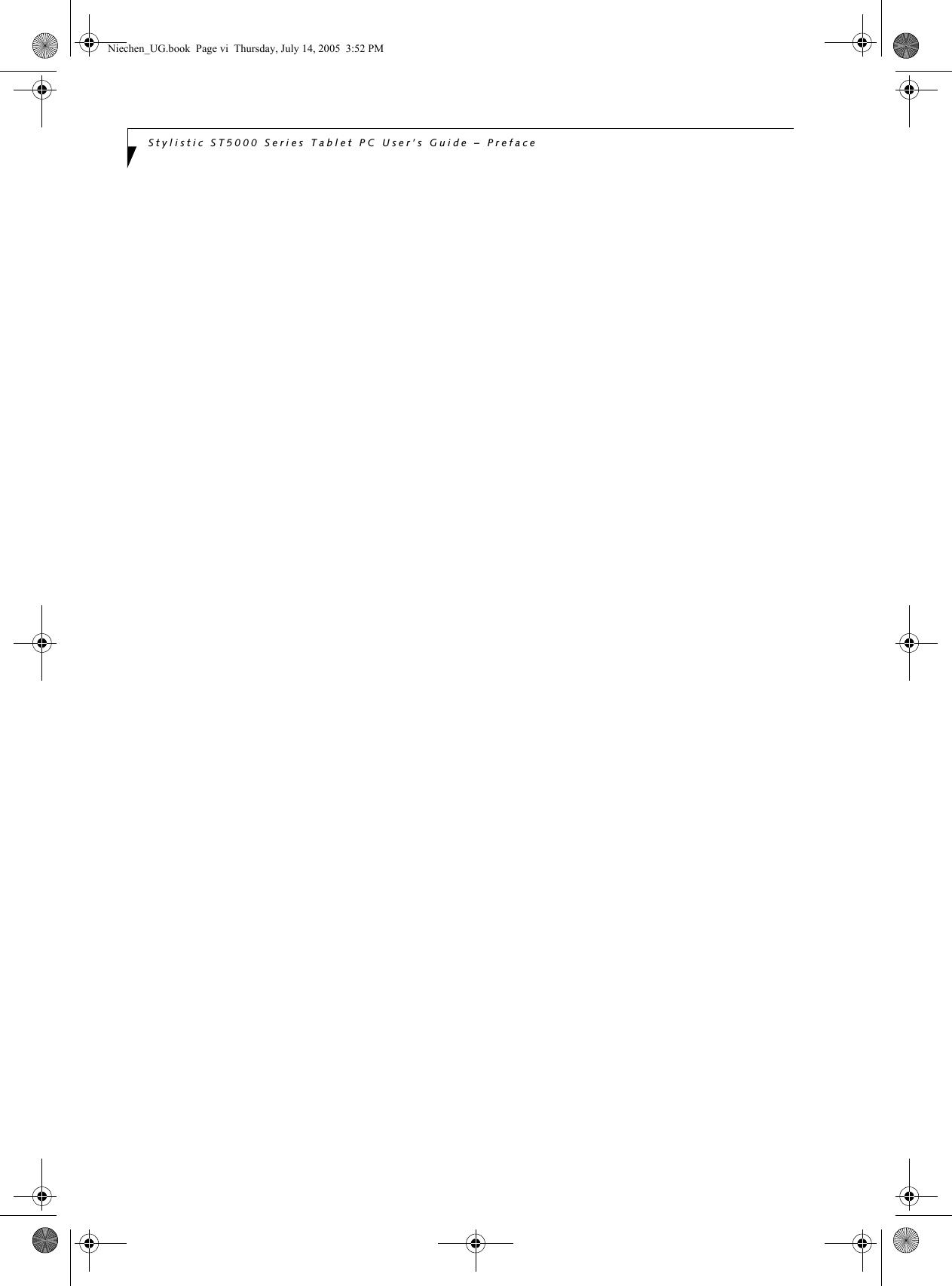
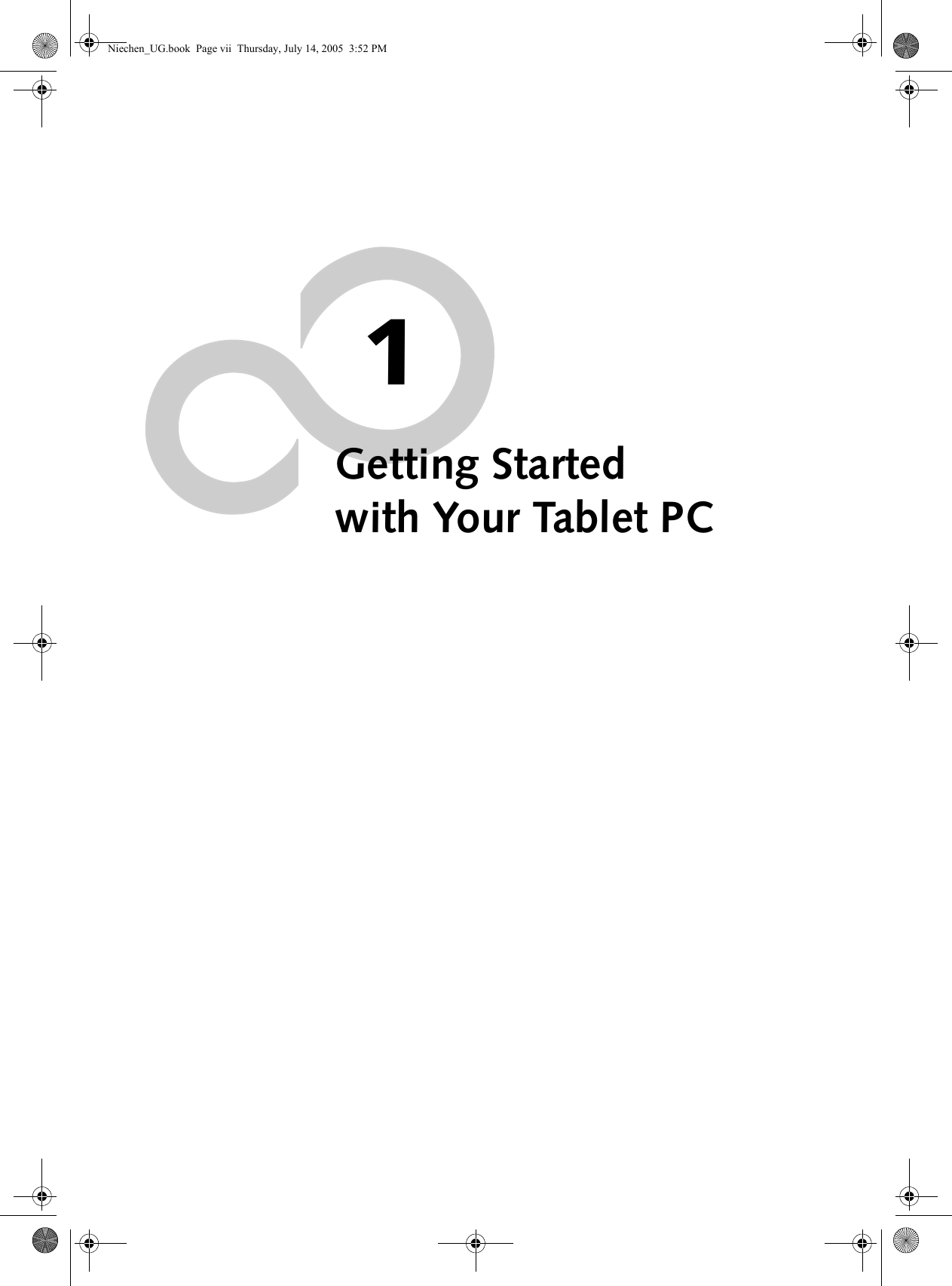
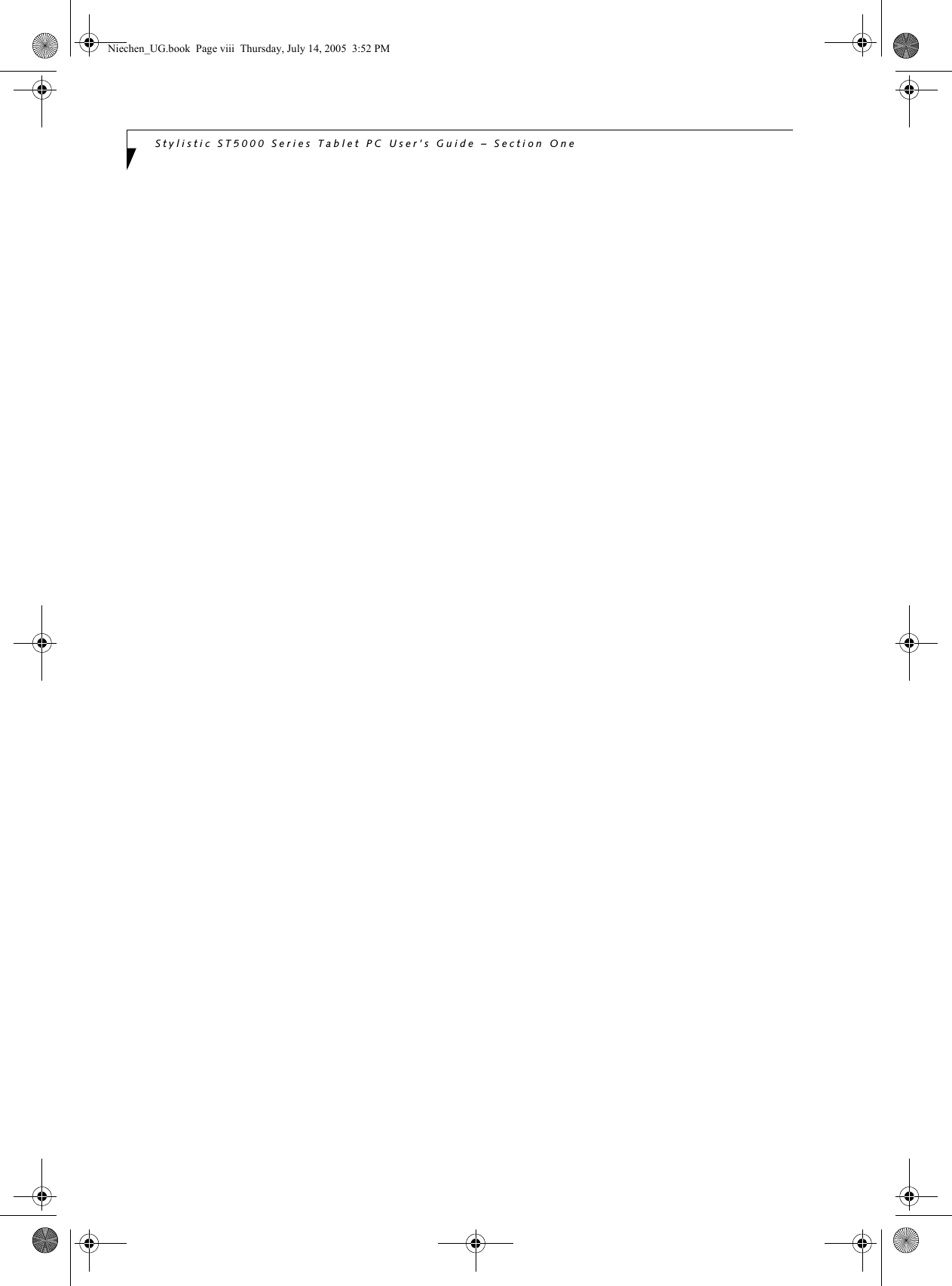
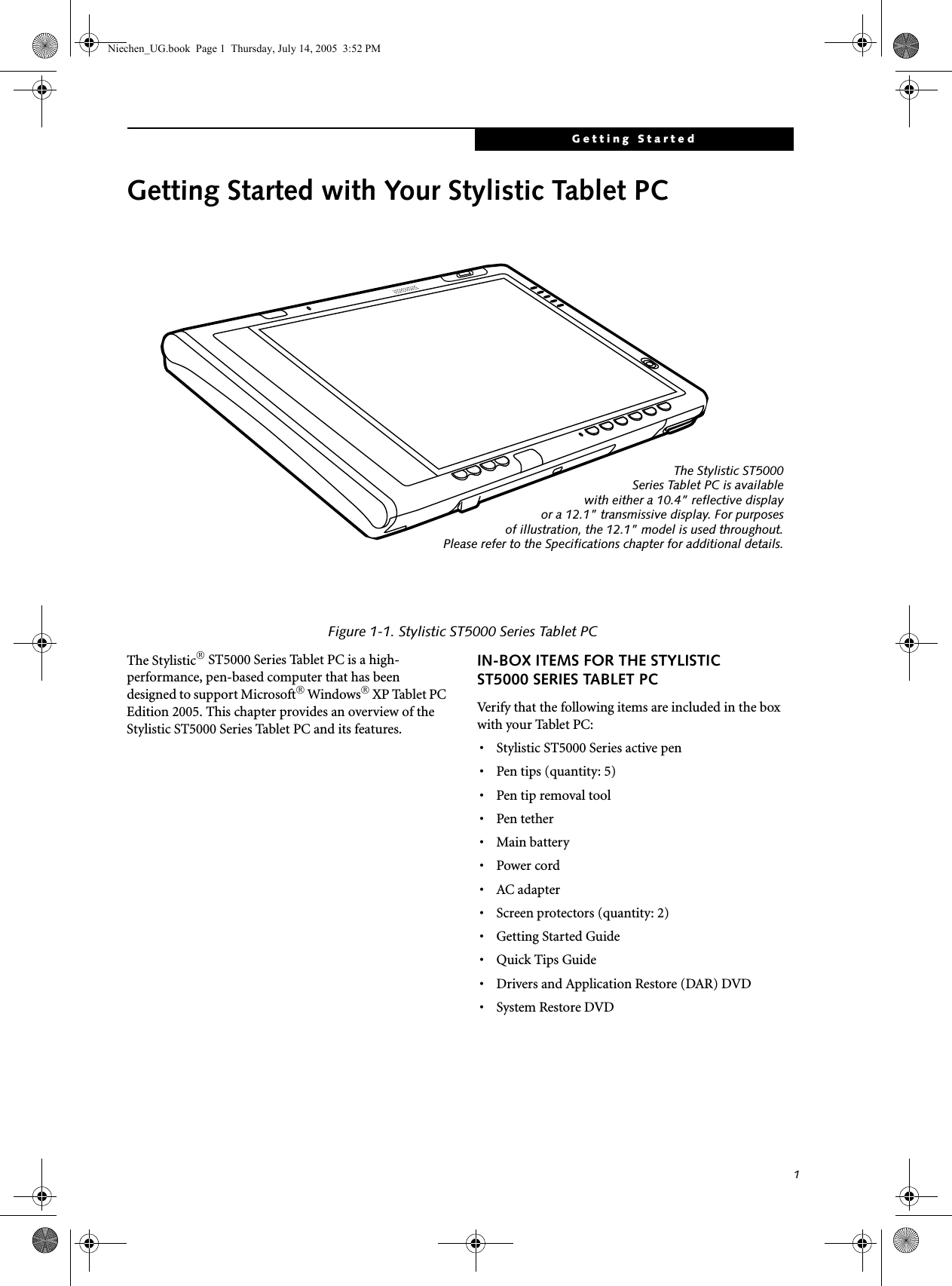
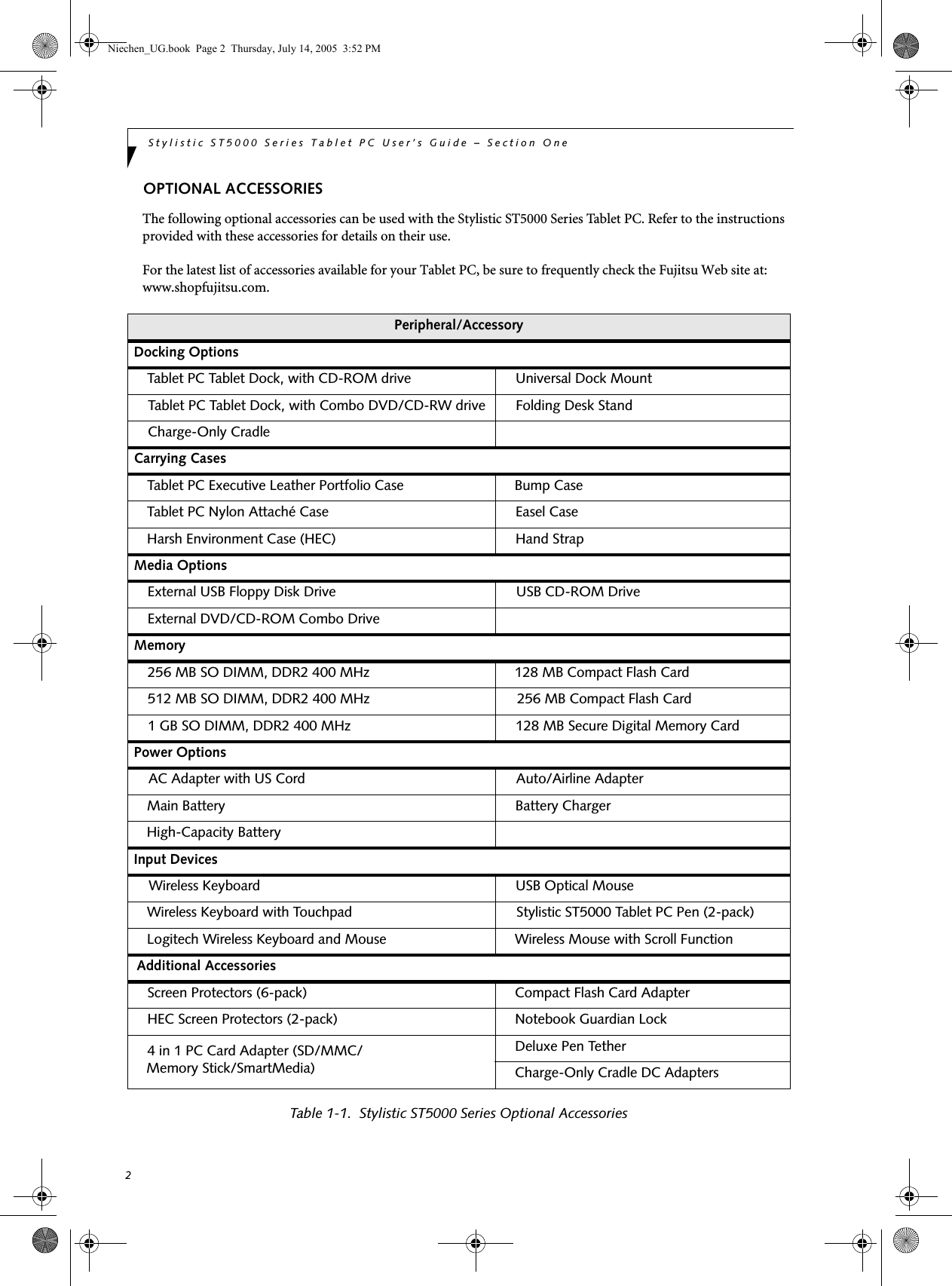
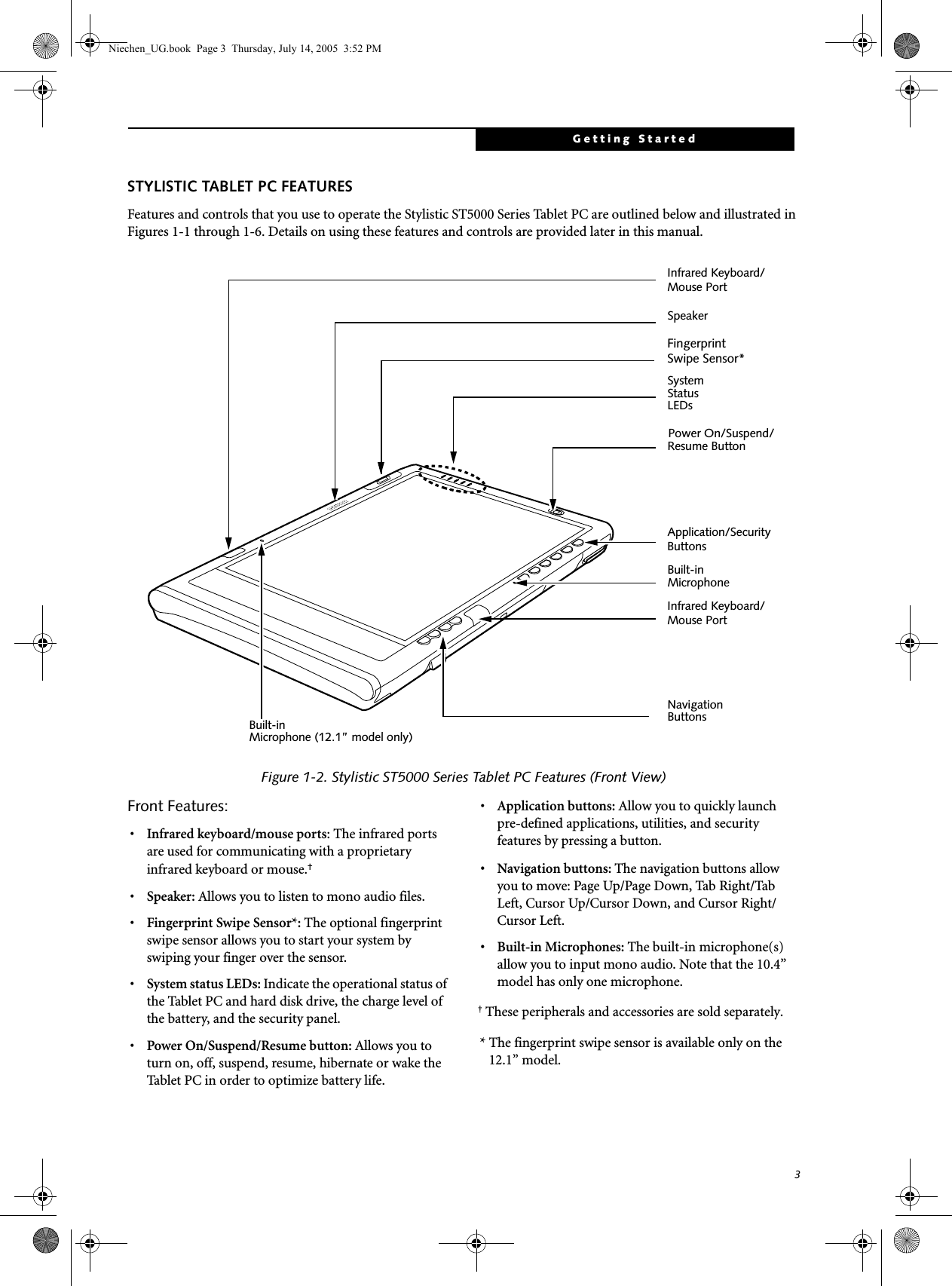
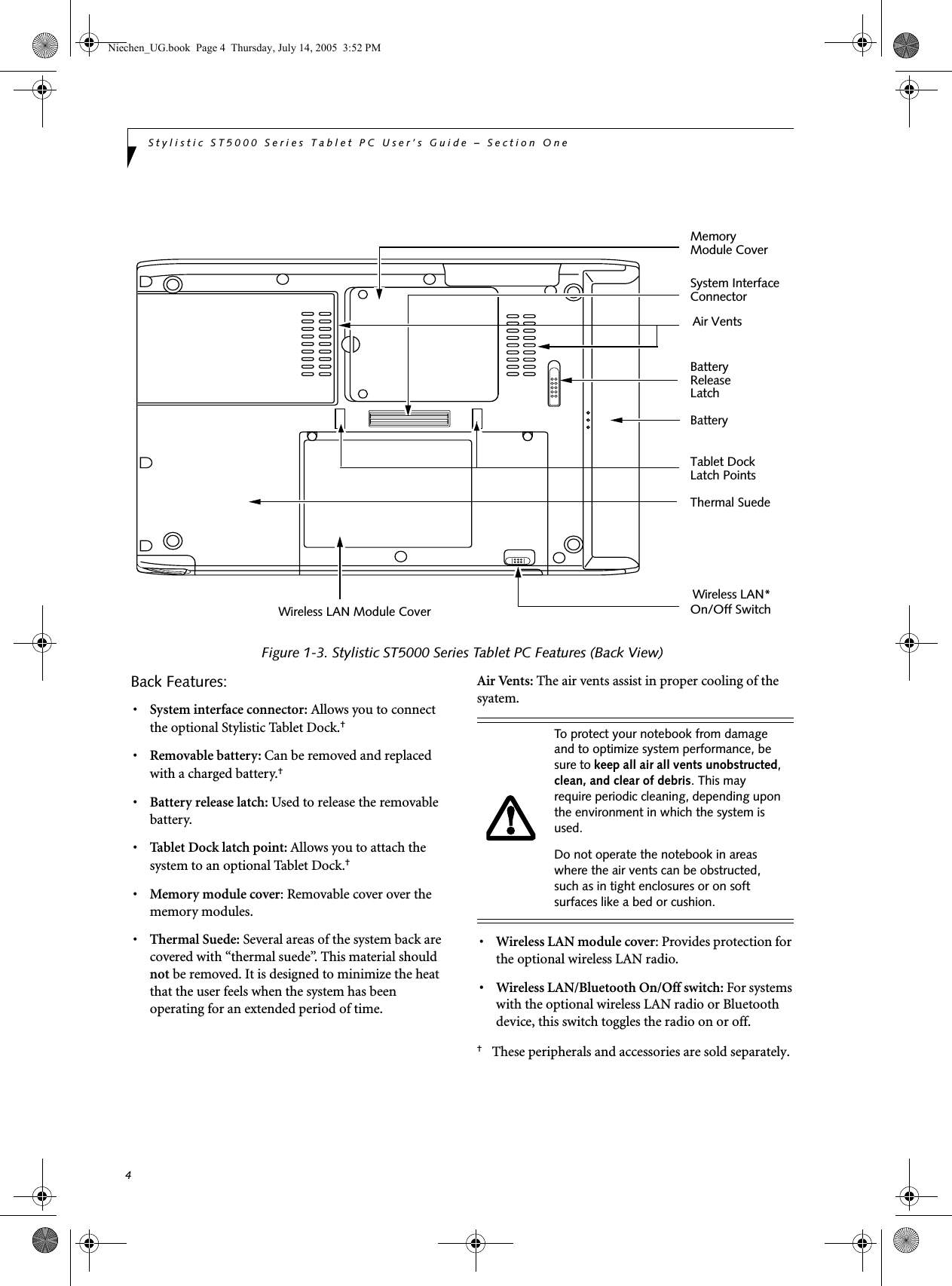
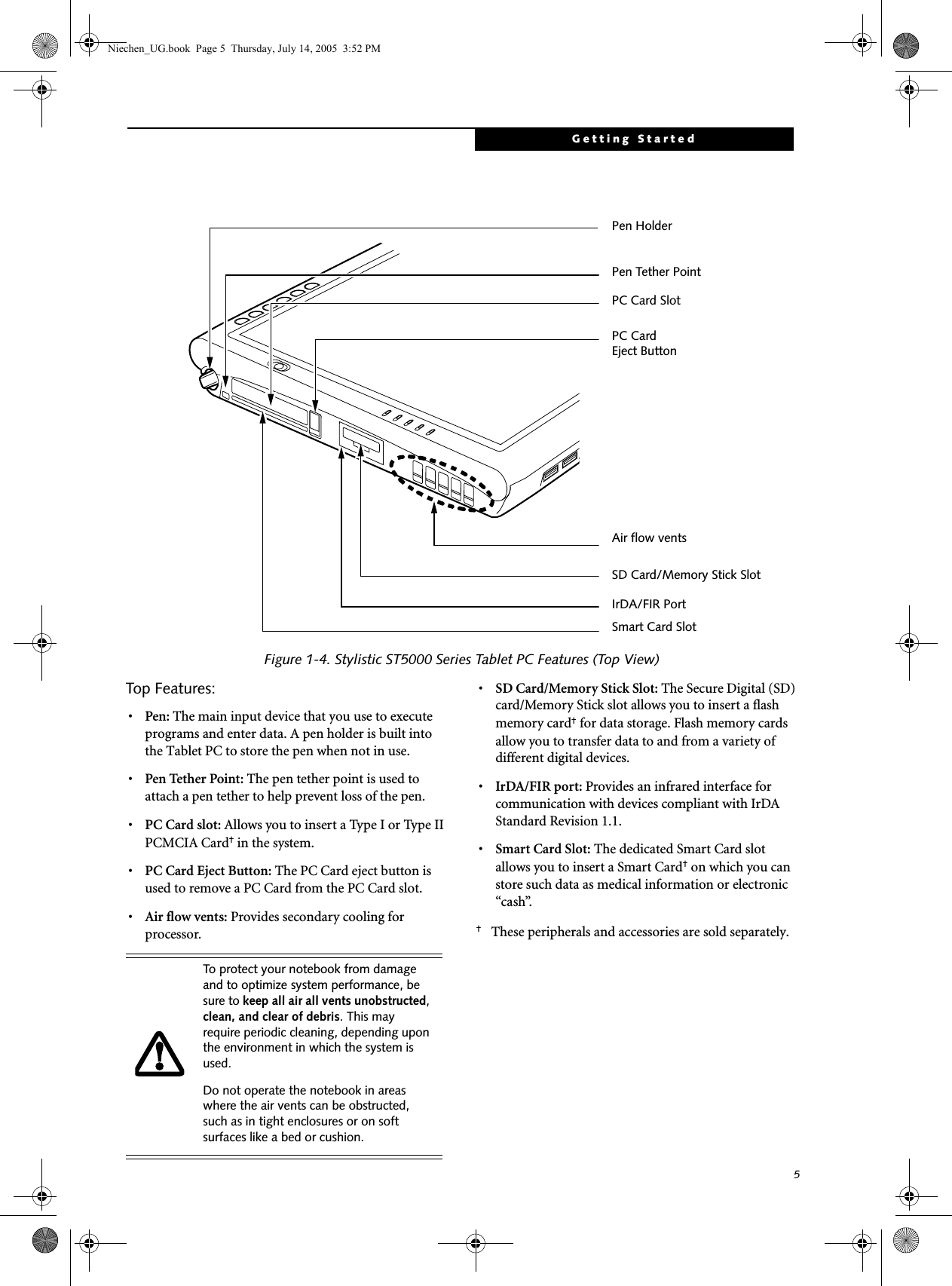
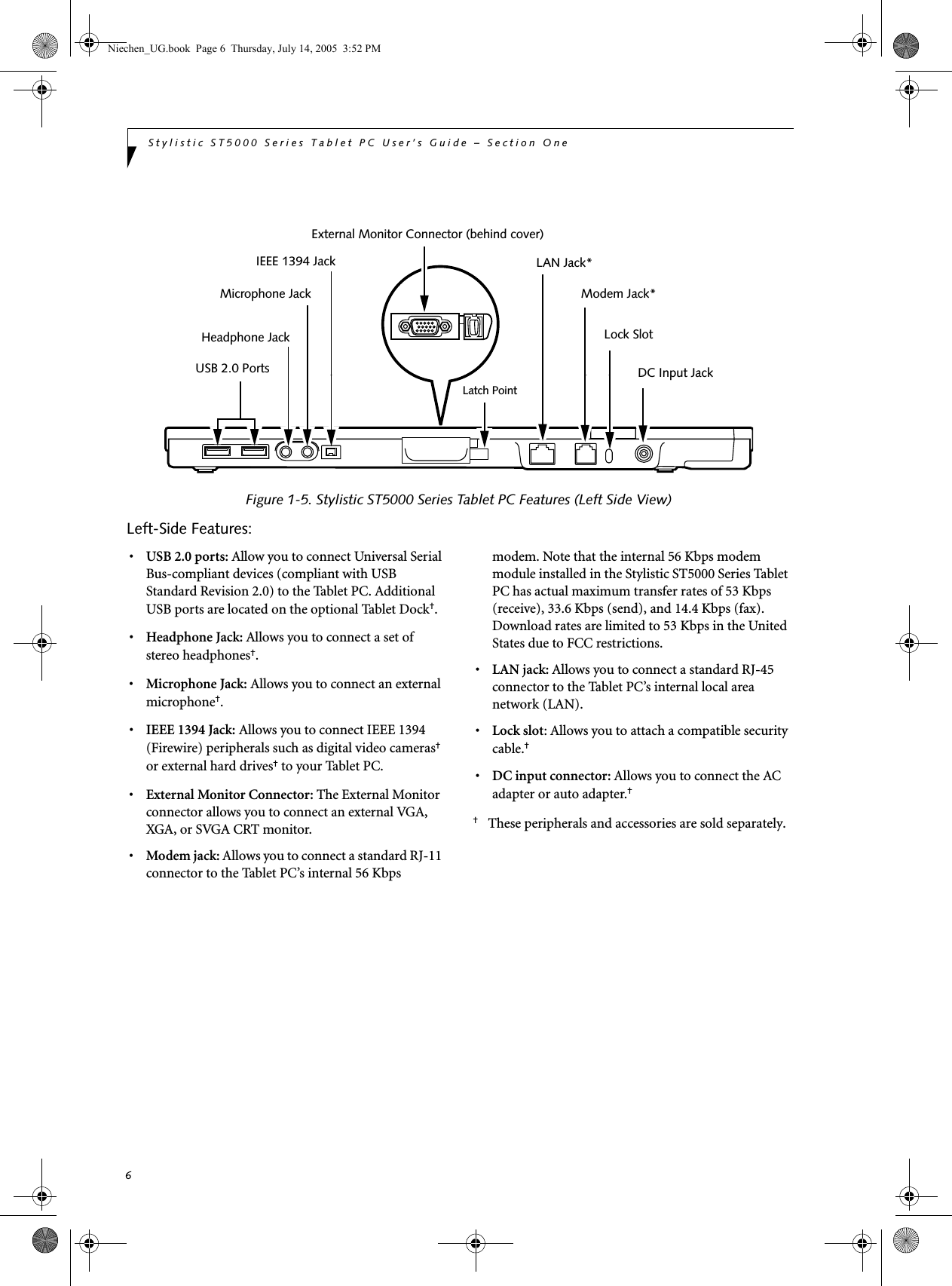
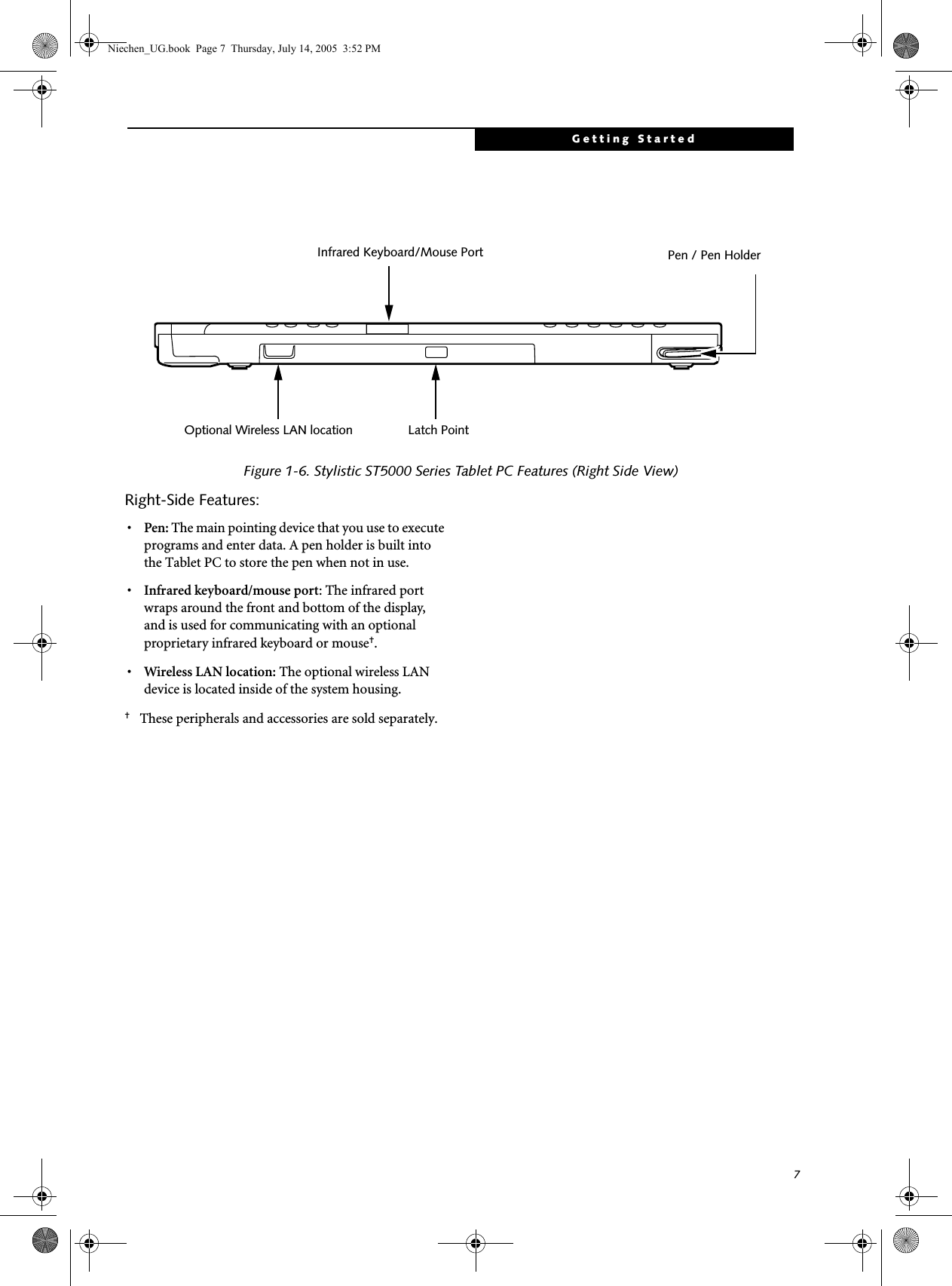
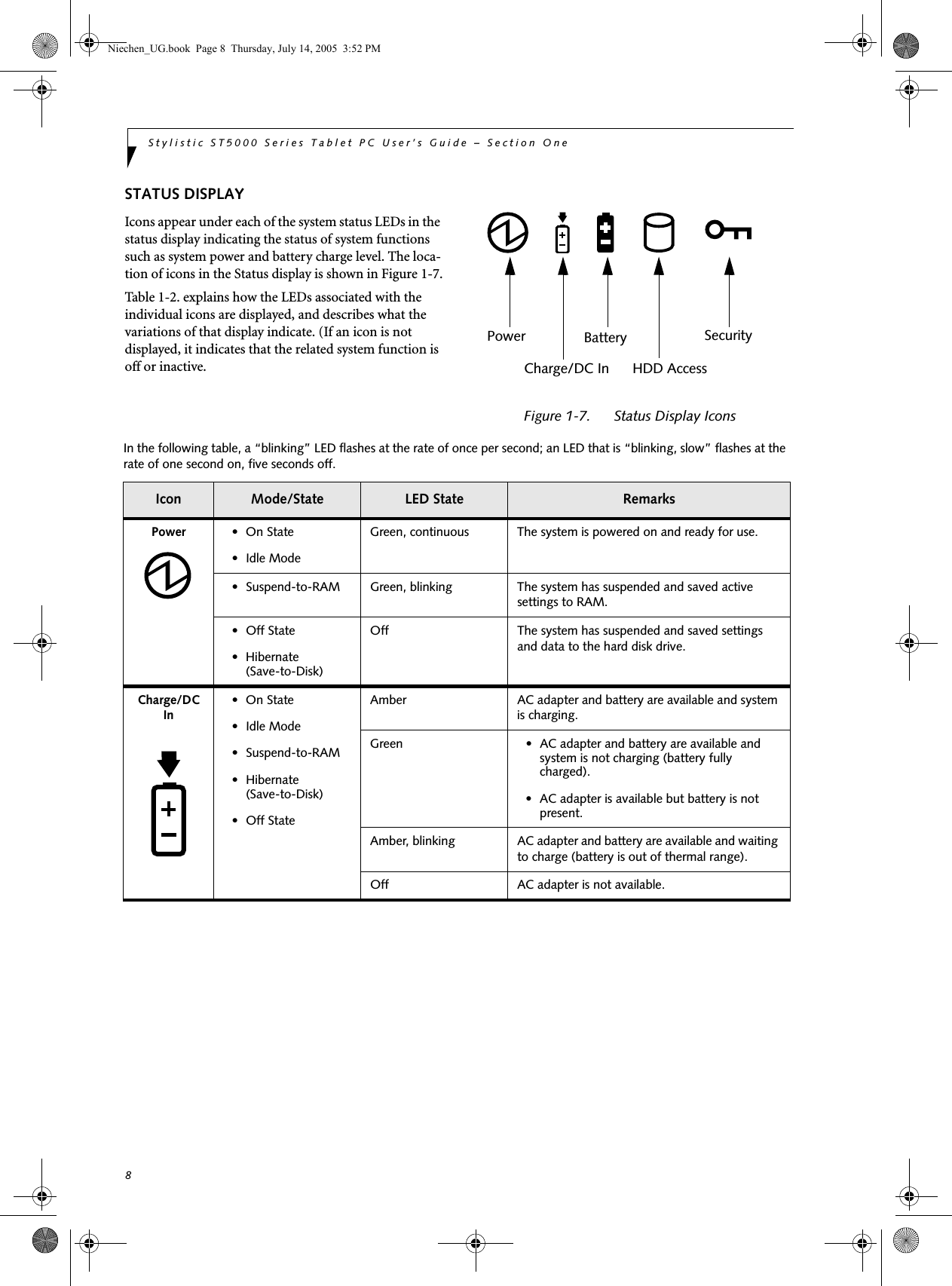
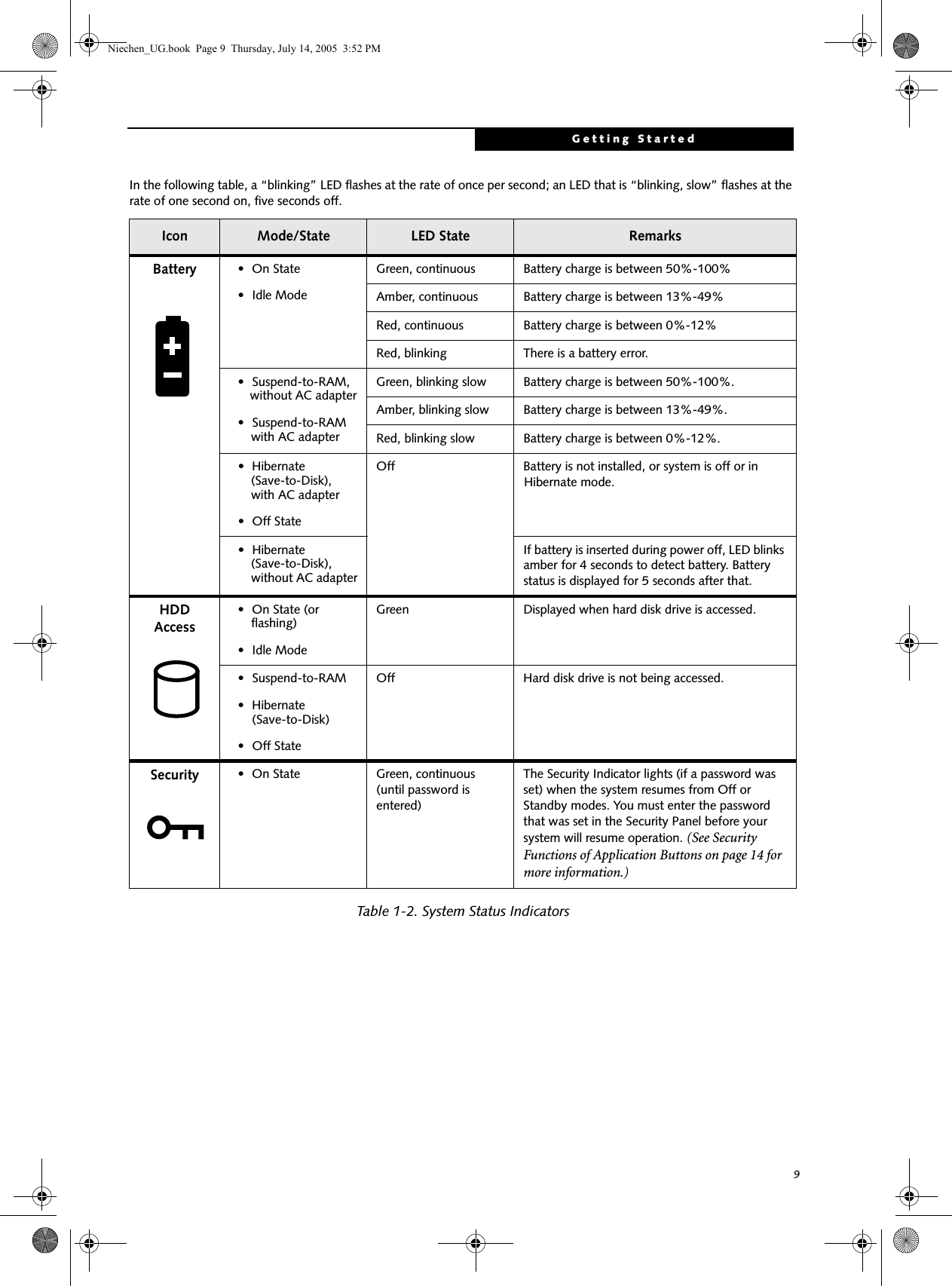
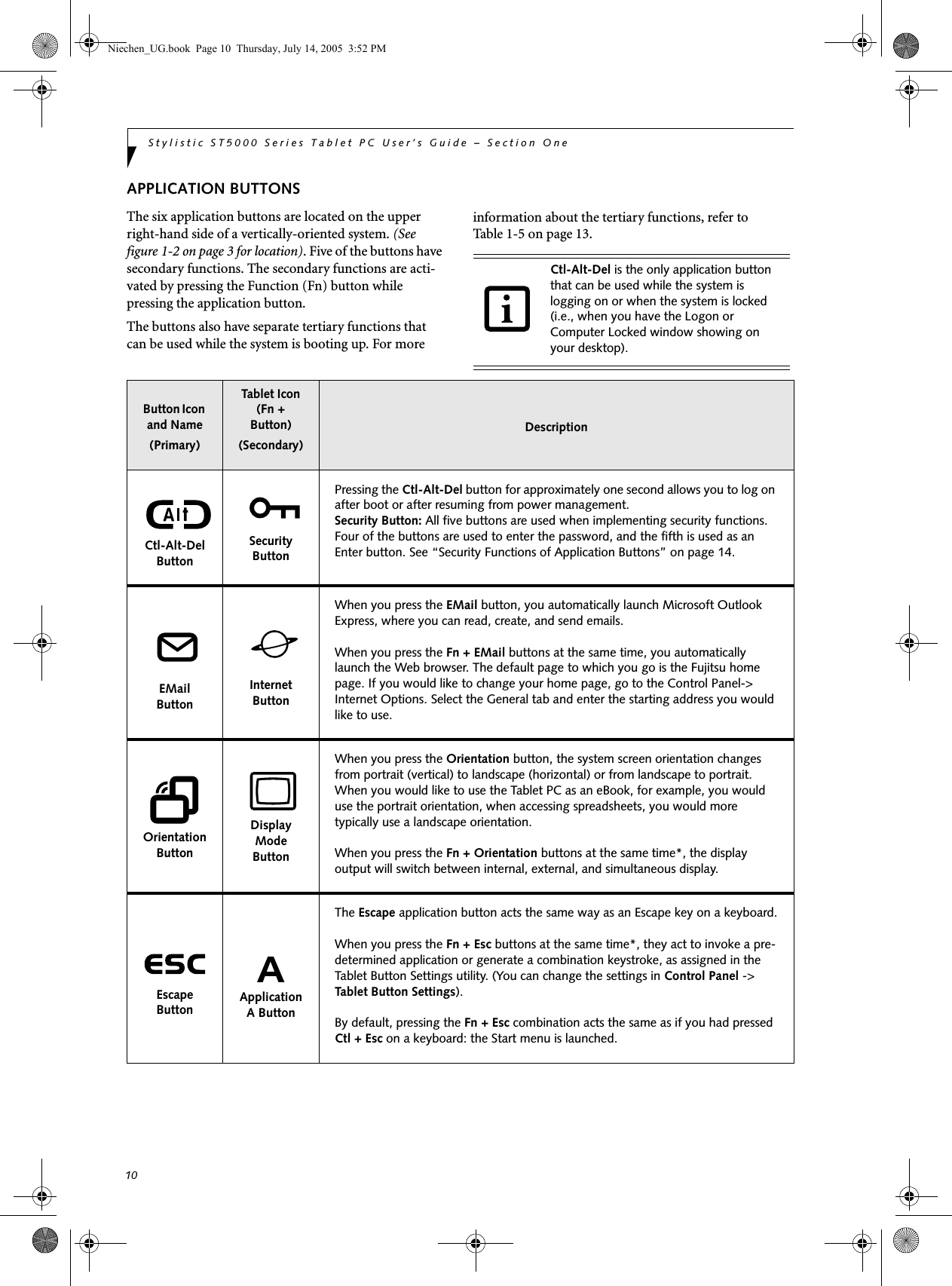
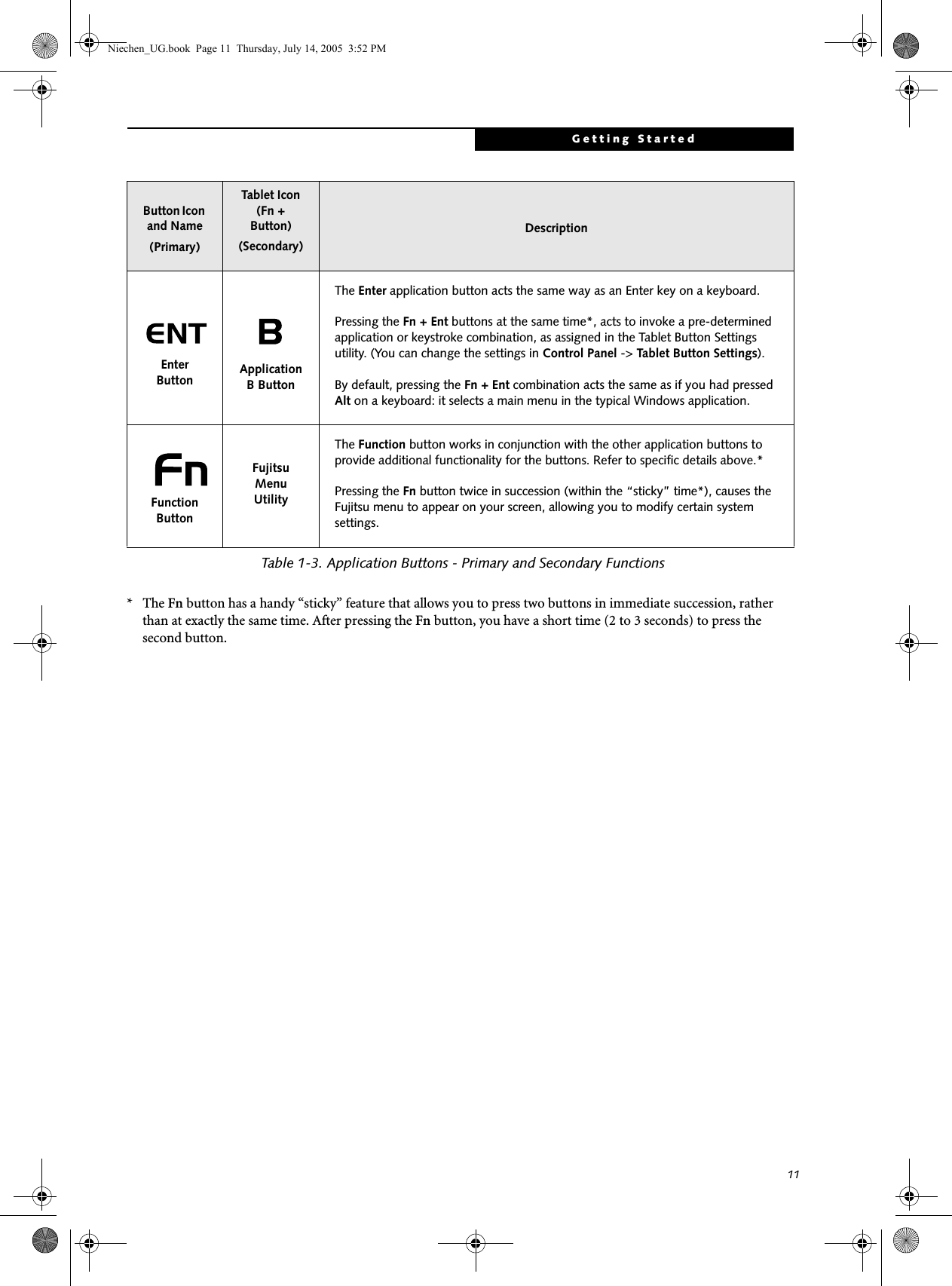
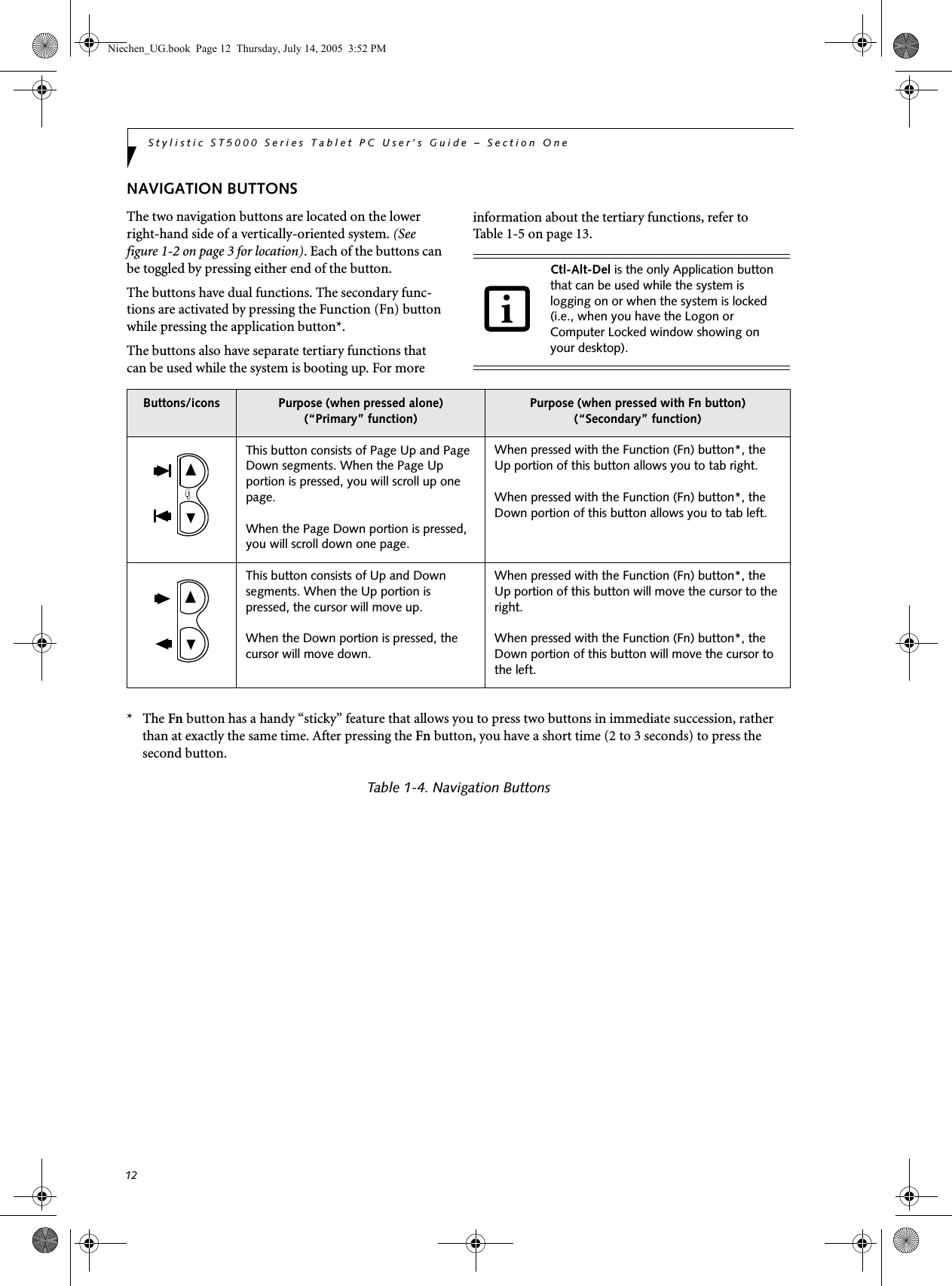
![13Getting StartedTERTIARY FUNCTIONS OF APPLICATION AND NAVIGATION BUTTONSWhile you are booting up your system, the Application Buttons and Navigation buttons can be used for entering and navigating through the Basic Input-Output System (BIOS), and for invoking the Advanced Options Menu, where you can enter different modes (such as Safe Mode).The BIOS is a program and a set of parameters that are stored in ROM, which tests and operates your Tablet PC from when you turn it on until it loads your installed operating system from disk. Information from the BIOS is transferred to the operating system to provide it with information on the configuration and status of the hard-ware.The system is booting up while the Fujitsu logo is displayed immediately after turning on the system. The table below indicates how the buttons act while the system is booting up and while you are in the BIOS.Table 1-5. Tertiary Functions of Application and Navigation ButtonsButtons/icons Purpose (when pressed while the system is booting up)Ctl-Alt-Del ButtonPressing the Ctl-Alt-Del button while the system is booting up takes you into BIOS setup. This is the same as if you had tapped [F2] on a keyboard.EMail ButtonPressing the EMail button while the system is booting up opens the Boot Options menu. This is the same as if you had tapped [F12] on a keyboard.Orientation ButtonPressing the Orientation button while the BIOS setup screen is open causes the selected item (if applicable) to change to the next item. Pressing this is the same as tapping the spacebar on a keyboard.Escape ButtonPressing the Esc button while the BIOS is open acts to escape from the BIOS. This is the same as if you had tapped [Esc] on a keyboard.Enter ButtonPressing the Ent button while the BIOS is open acts the same as the [Ent] button on a keyboard. Function ButtonPressing the Fn button while the system is displaying the operating system boot menu, opens the Advanced Operating System Options menu. This menu allows you to enter different operating system modes (such as Safe Mode). Pressing this button is the same as if you had tapped [F8] on a keyboard.Pressing the top half of the upper navigation button while the BIOS setup screen is open causes the cursor in the BIOS setup screen to move up. This is the same as if you had tapped Arrow Up on a keyboard. This feature is also functional in the operating system boot menu.Pressing the bottom half of the upper navigation button while the BIOS setup screen is open causes the cursor in the BIOS setup screen to move down. This is the same as if you had tapped Arrow Down on a keyboard. This feature is also functional in the operating system boot menu.Pressing the top half of the lower navigation button while the BIOS setup screen is open causes the cursor in the BIOS setup screen to move right. This is the same as if you had tapped Arrow Right on a keyboard.Pressing the bottom half of the lower navigation button while the BIOS setup screen is open causes the cursor in the BIOS setup screen to move left. This is the same as if you had tapped Arrow Left on a keyboard.Niechen_UG.book Page 13 Thursday, July 14, 2005 3:52 PM](https://usermanual.wiki/Fujitsu-Client-Computing/WB0043.App-I1-user-manual-part-1/User-Guide-697892-Page-24.png)
![14Stylistic ST5000 Series Tablet PC User’s Guide – Section OneSECURITY FUNCTIONS OF APPLICATION BUTTONSFive buttons are used when implementing security functions. Four of the buttons are used to enter the password, and the fifth is used as an Enter button. Instructions for using the security feature follow the table.Table 1-6. Security Functions of Application ButtonsSETTING UP THE SECURITY PANELWhen you receive your Tablet PC, the security panel application is pre-installed without any passwords. The following sections provide detailed information on your security panel, how to set, change or remove passwords.Numbered ButtonsUse these buttons to enter your password.(Figure 1-6)Enter ButtonAfter entering the button strokes, push this button to enter the password into the Tablet PC. (Figure 1-6)PASSWORDSThe user and supervisor password may be set on this Tablet PC. A supervisor password is typically the same for all Tablet PC’s and notebooks in a work group, office, or company to allow for system management. Individual computers in a group environment should not use a common password. A password consists of one to five button strokes plus the enter button. A valid stroke consists of pushing one or up to four buttons simulta-neously. The following are valid button strokes: ■Pushing [4] by itself■Pushing [2] and [3] at the same time■Pushing [1], [2], and [4] at the same time■Pushing [1], [2], [3], and [4] at the same timeThe following are valid passwords. The numbers within braces ({ }) are button strokes using more than one button. ■{[2]+[3]}, [1], [Enter]■[4], [enter]■{[1]+[3]}, {[2]+[3]+[4]}, [1], [4], [2], [Enter]Setting PasswordsWhen shipped from the factory, no passwords are set. You have a choice of having no password or setting a supervisor and user password. You must set the super-visor password before the user password. Button Icons Security Icons Security PurposeCtl-Alt-Del ButtonSecurity Enter ButtonEMail Button1Security Button 1Orientation Button2Security Button 2Escape Button3Security Button 3Enter Button4Security Button 4■The purpose of supervisor password is to be able to bypass the user password in case the user password is forgotten. The supervisor password alone will not lock the system.■You must set the supervisor and user passwords for the security panel to work.Niechen_UG.book Page 14 Thursday, July 14, 2005 3:52 PM](https://usermanual.wiki/Fujitsu-Client-Computing/WB0043.App-I1-user-manual-part-1/User-Guide-697892-Page-25.png)
![15Getting StartedSetting Supervisor PasswordYou must have set a supervisor password before setting any user passwords. The supervisor password can bypass the user password.1. Go to the Start menu.2. Click on Run.3. Type in:C:\Program Files\Fujitsu\Security Panel Application\Supervisor\ FJSECS.EXE, then press [Enter]4. Follow the on-screen instructions to set theSupervisor password.Setting User Password1 Go to the Start menu.2. Click on All Programs.3. Click on Security Panel Application -> Security Panel Application.4. Follow the on-screen instructions to set theuser password.USING YOUR SECURITY PANELThe security lock feature is in effect both when the system resumes from Off, Standby, or Hibernation state. You always need to push the Security Panel buttons to input the user password. Your system will not begin the boot sequence until you enter your supervisor/user password.From Off State1. Turn on your system.2. When the Security Indicator flashes, enter the pass-word and press Enter button.For example, if the password is 22222, first press Button 2 five times and press the Enter button. The Tablet PC will boot to normal operation.From Standby/Hibernation State1. Press your Suspend/Resume button.2. When the Security Indicator flashes, enter the pass-word and press Enter button.The Tablet PC should resume normal operation.Incorrect Password EntryIf an invalid supervisor or user password is entered three times in succession, the system will “beep” for about one minute. If a valid password is entered within a minute (while system beeps), the beeping will stop and the Tablet PC will resume normal operation. If no password is entered or an invalid password is entered while the system beeps, the system will return to its previous locked state (standby or off) and the Security Indicator will go off. To reactivate the Tablet PC after a password failure, you must press the Suspend/Resume button, then enter a correct password.PRECAUTIONSLow Battery OperationsIf your Tablet PC has a low battery, pushing the suspend/resume button does not unlock the Tablet PC. To resume normal operation, first attach a power supply to the system. Then you may unlock the Tablet PC.UNINSTALLING THE SECURITY PANEL APPLICATIONYou have two options when uninstalling the securitypanel application:■Remove passwords and uninstall the security panel application software. This will disable all security features.■Uninstall the security panel application with password still active. This will not allow any changes to the password. Uninstalling the Security Panel Application SoftwareRemove passwords when User wants no password protec-tion whatsoever and doesn’t want to give anybody the utility to set a password on their computer. In this case, if passwords (supervisor, user, or both) are set, the pass-words must first be cleared BEFORE removing the appli-cation. To clear passwords, follow same procedure in SETTING PASSWORD CODES except this time, select REMOVE, enter current password then click Next. When asked to confirm select Ye s .You may change or remove the supervisor or user password by repeating the steps defined above.Remember the user password you specified on the Security Panel Application. If you forget the password you will not be able to use your computer. The supervisor pass-word can override the user password.Niechen_UG.book Page 15 Thursday, July 14, 2005 3:52 PM](https://usermanual.wiki/Fujitsu-Client-Computing/WB0043.App-I1-user-manual-part-1/User-Guide-697892-Page-26.png)
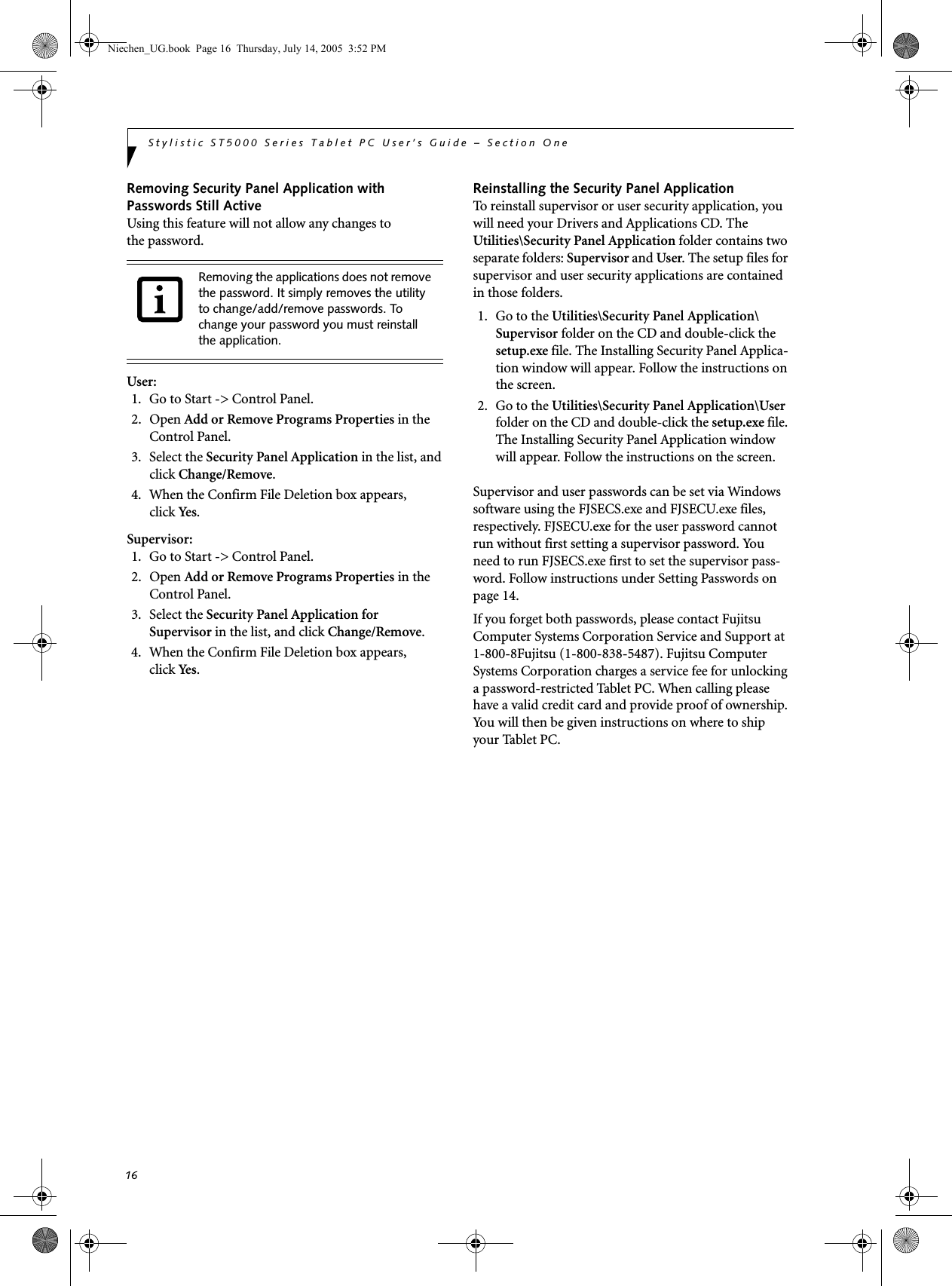
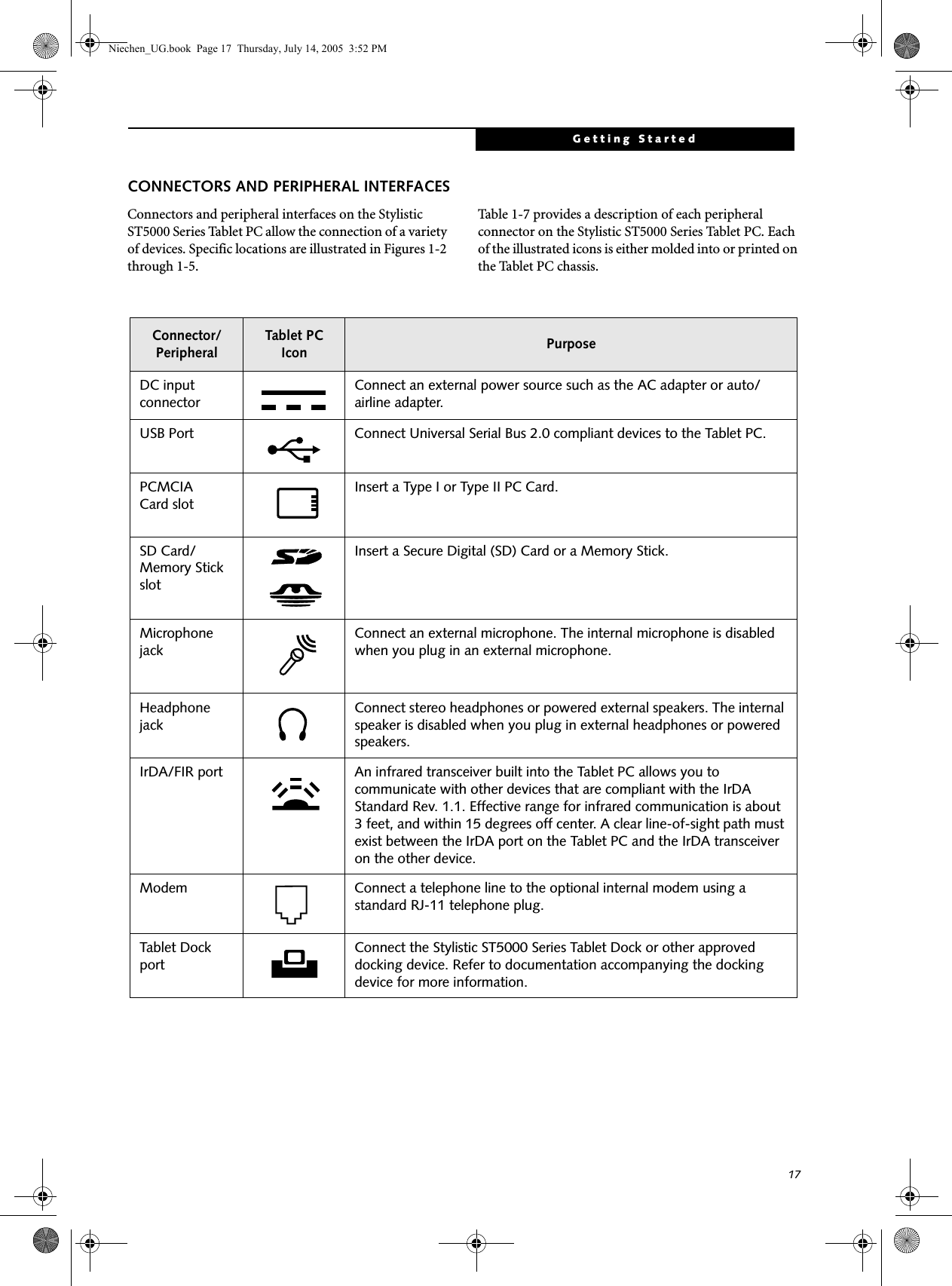
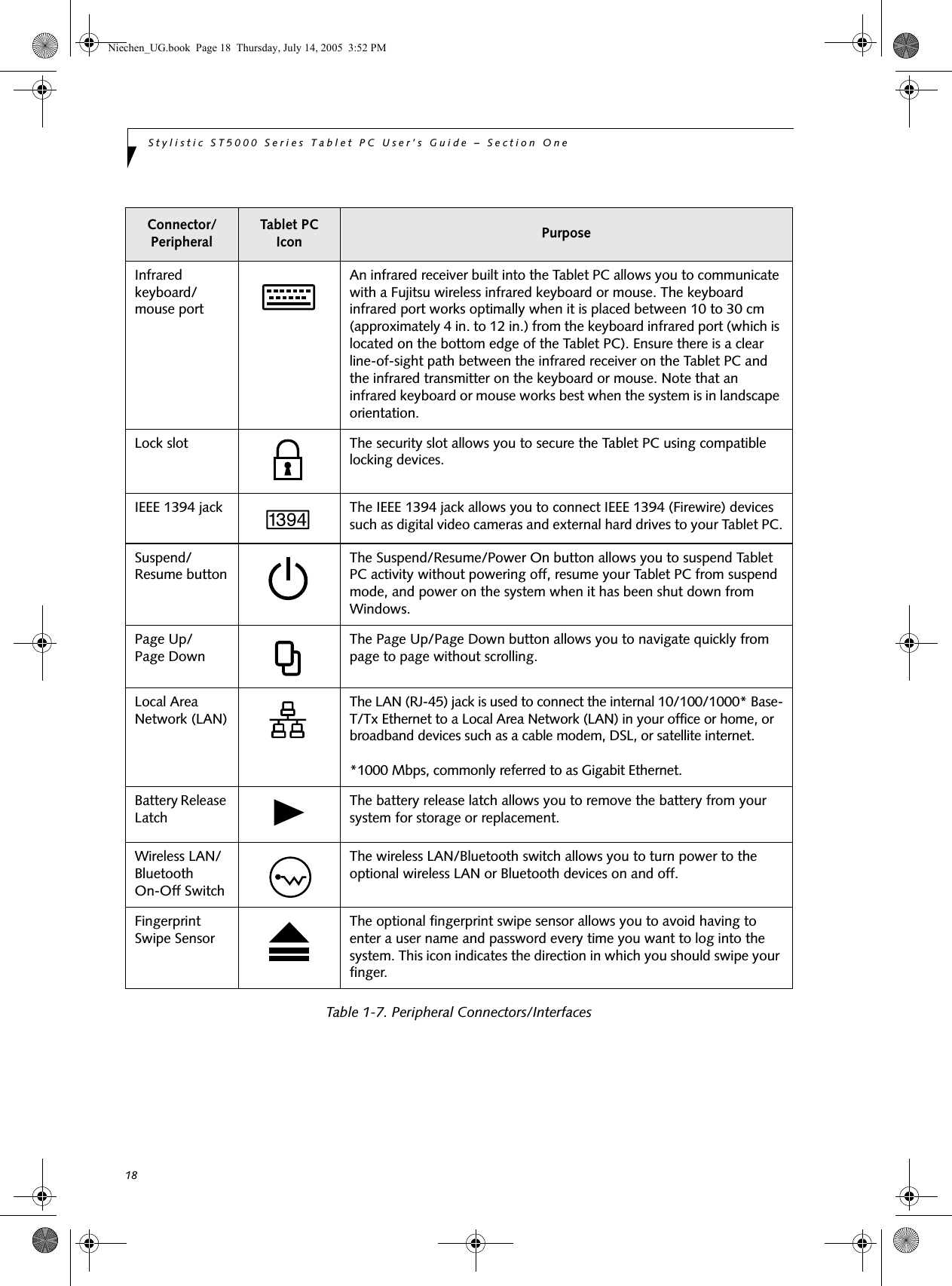
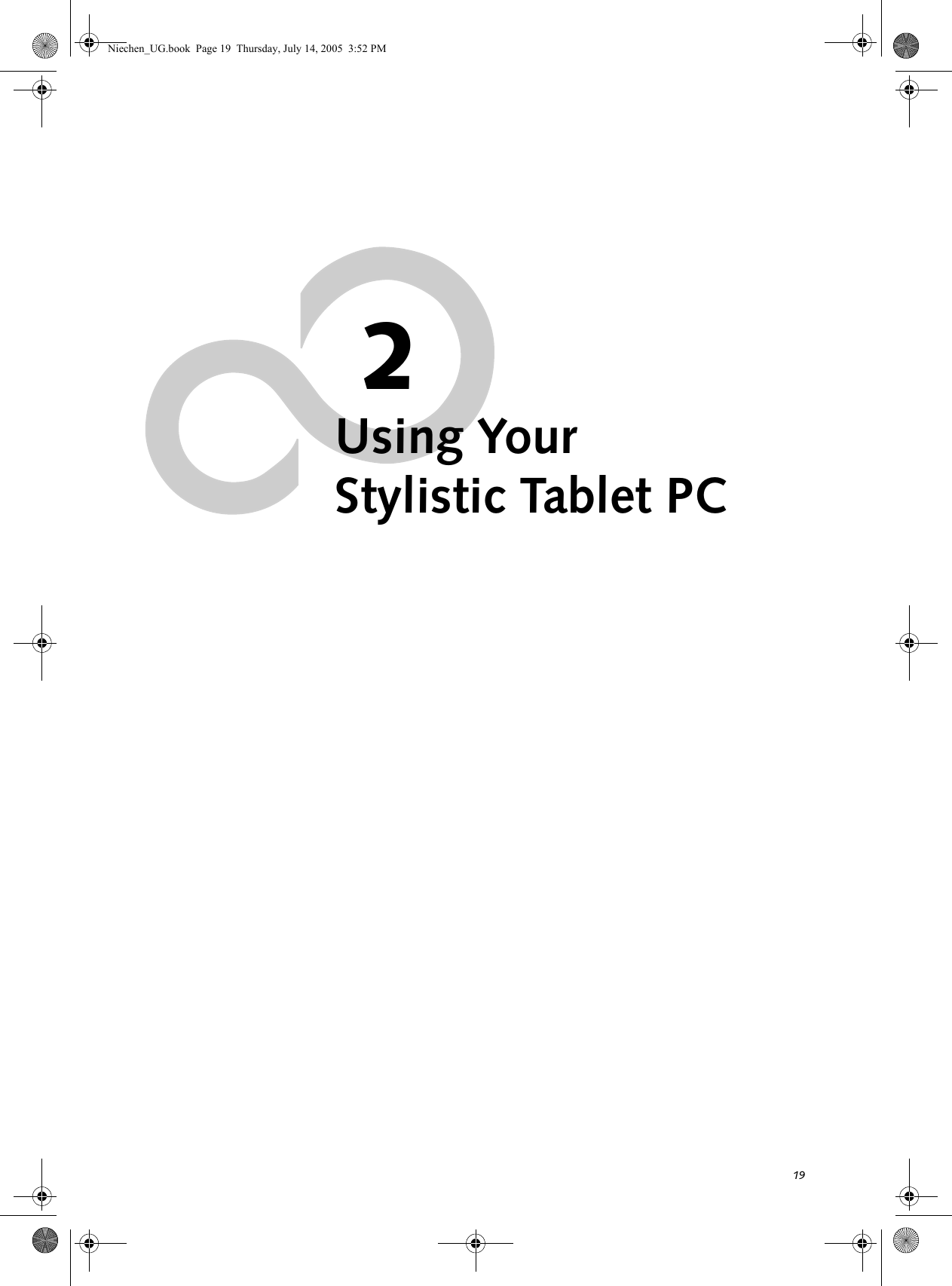
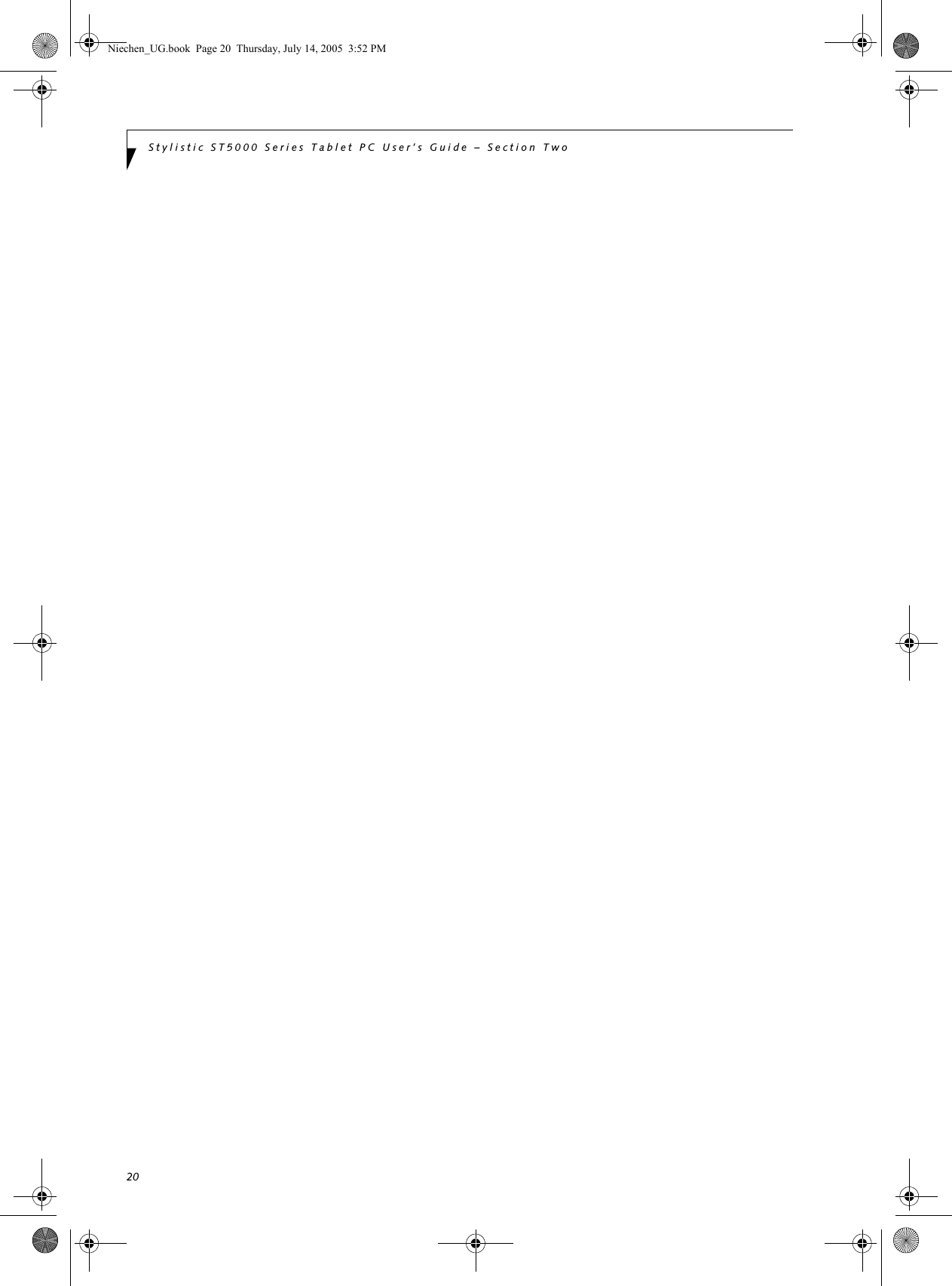
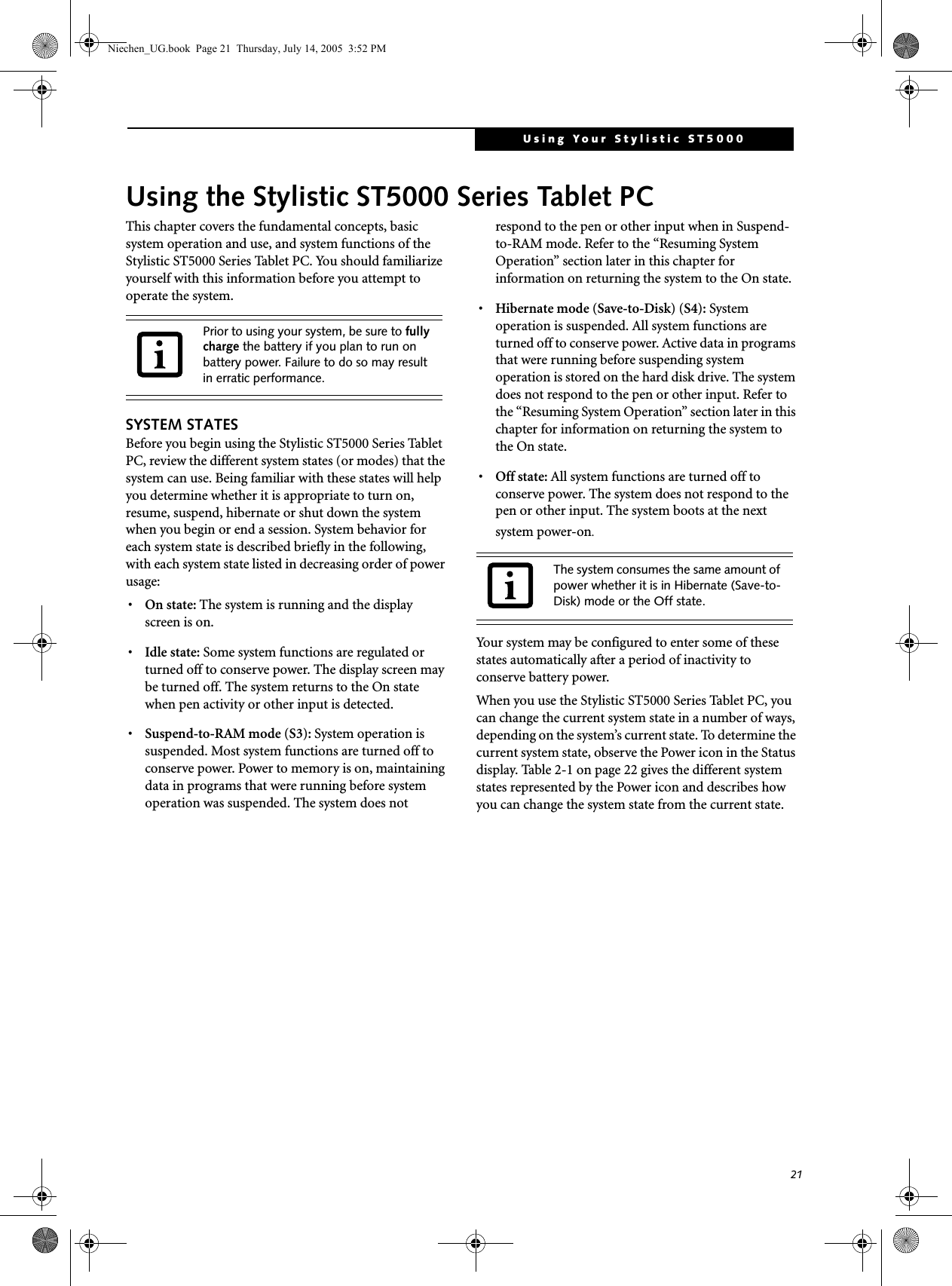
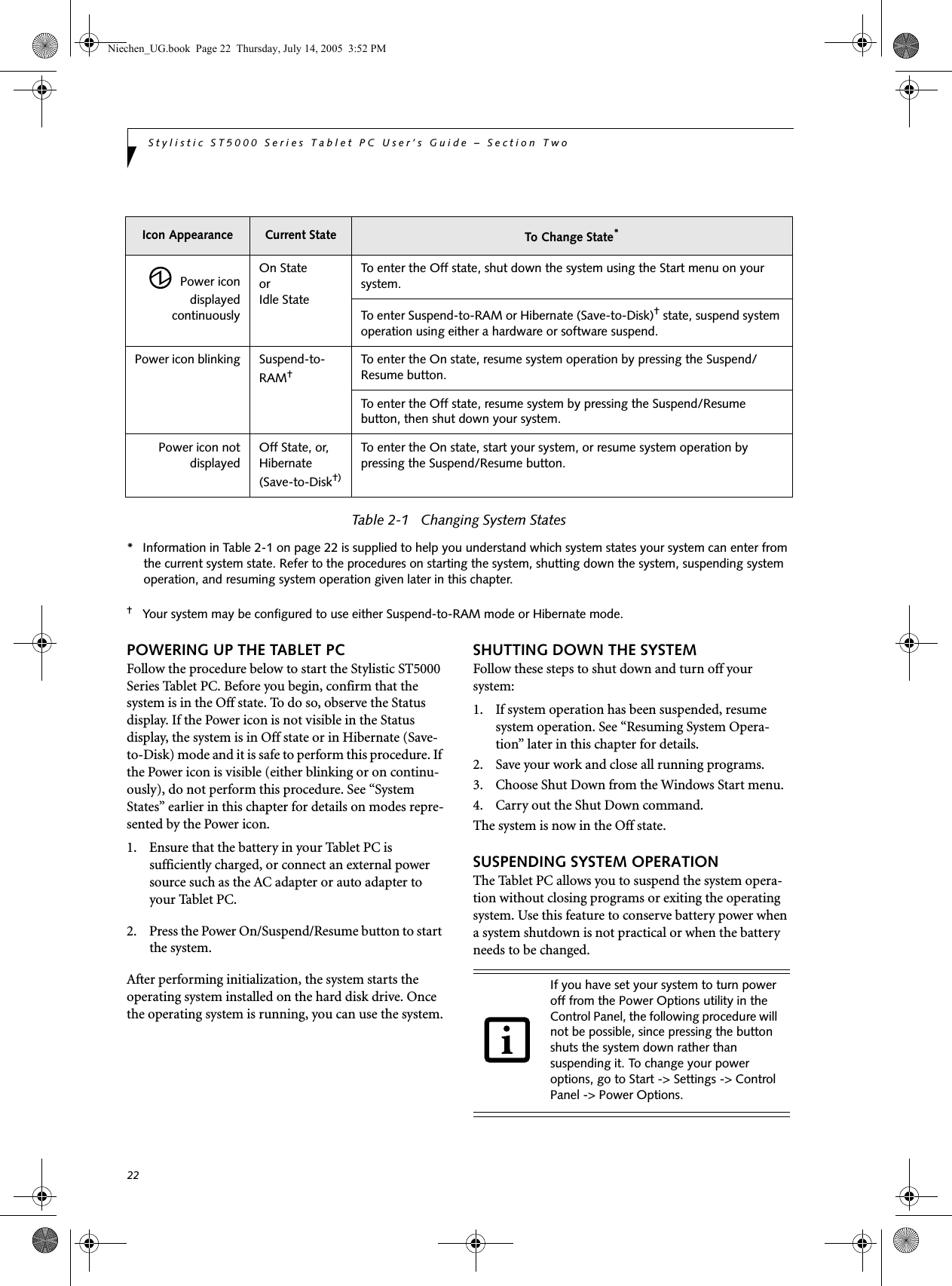
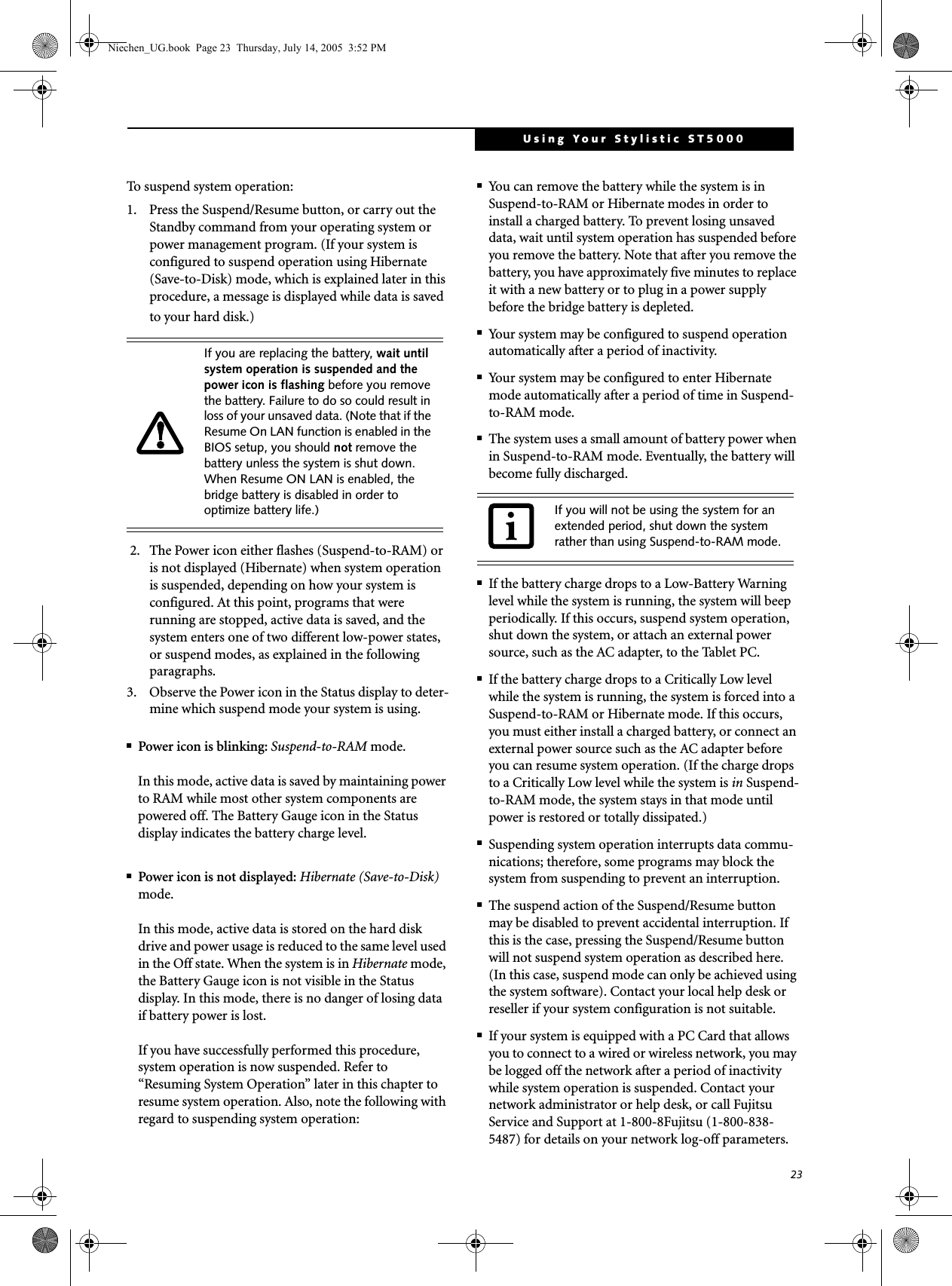
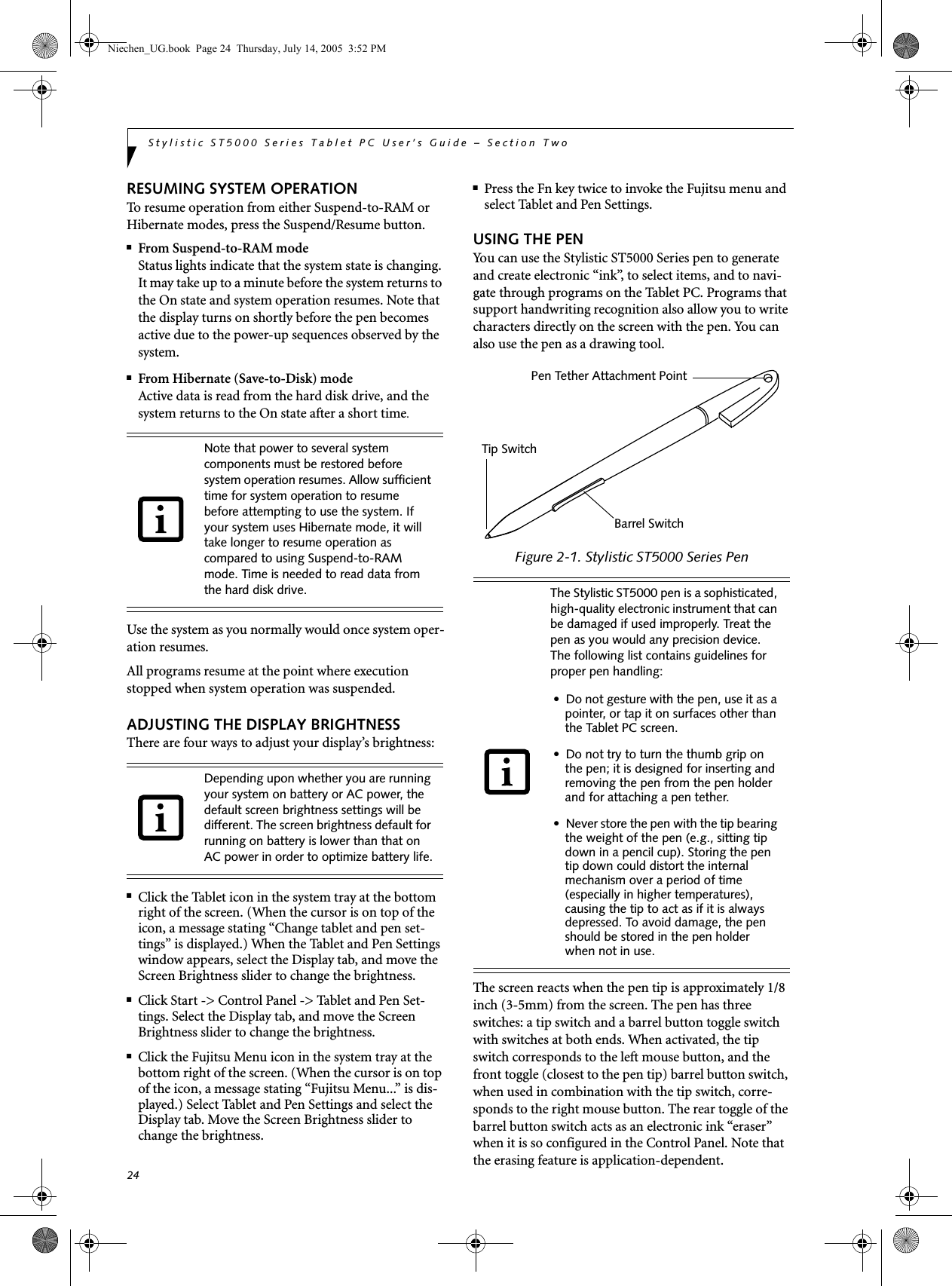
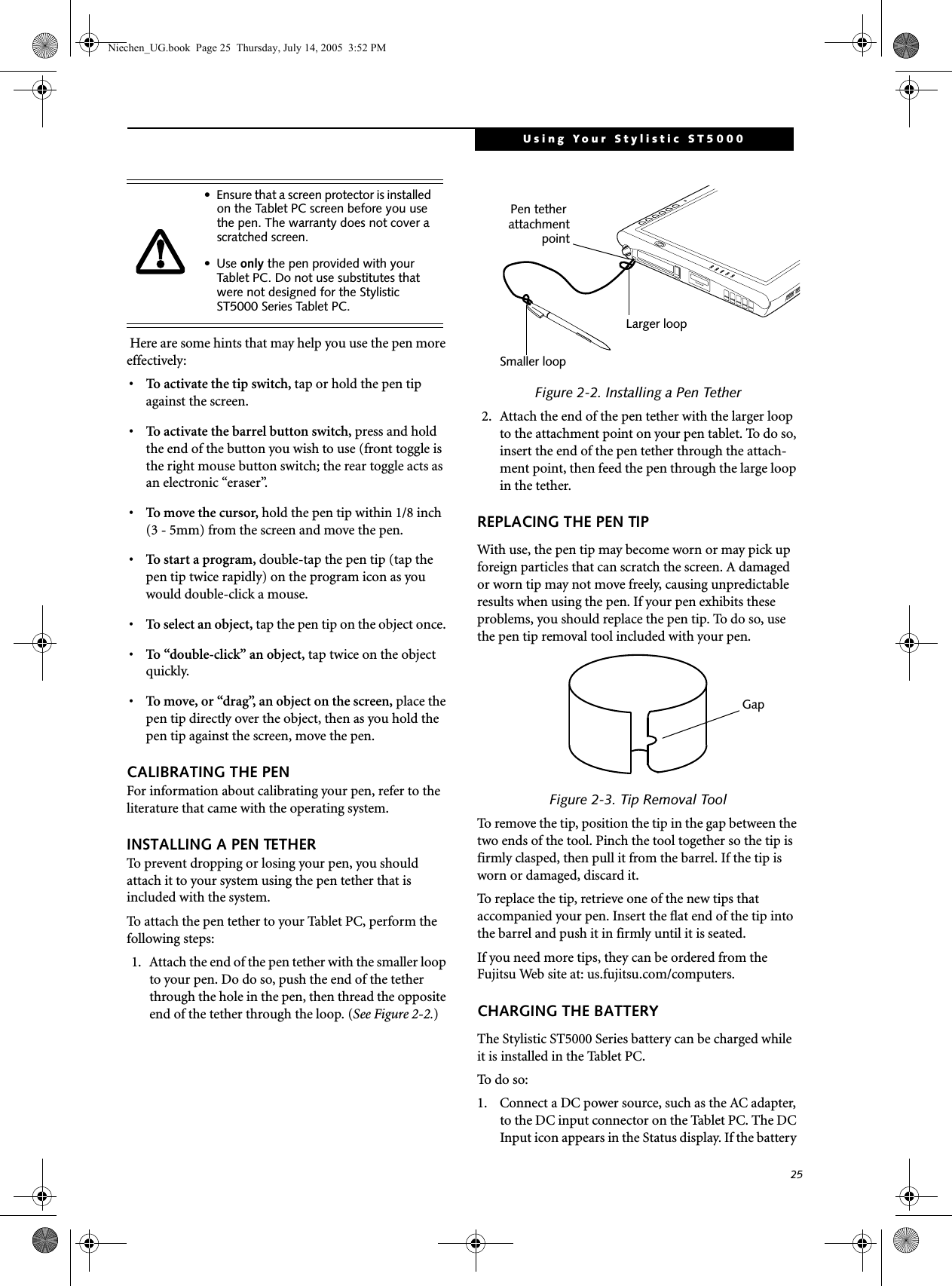
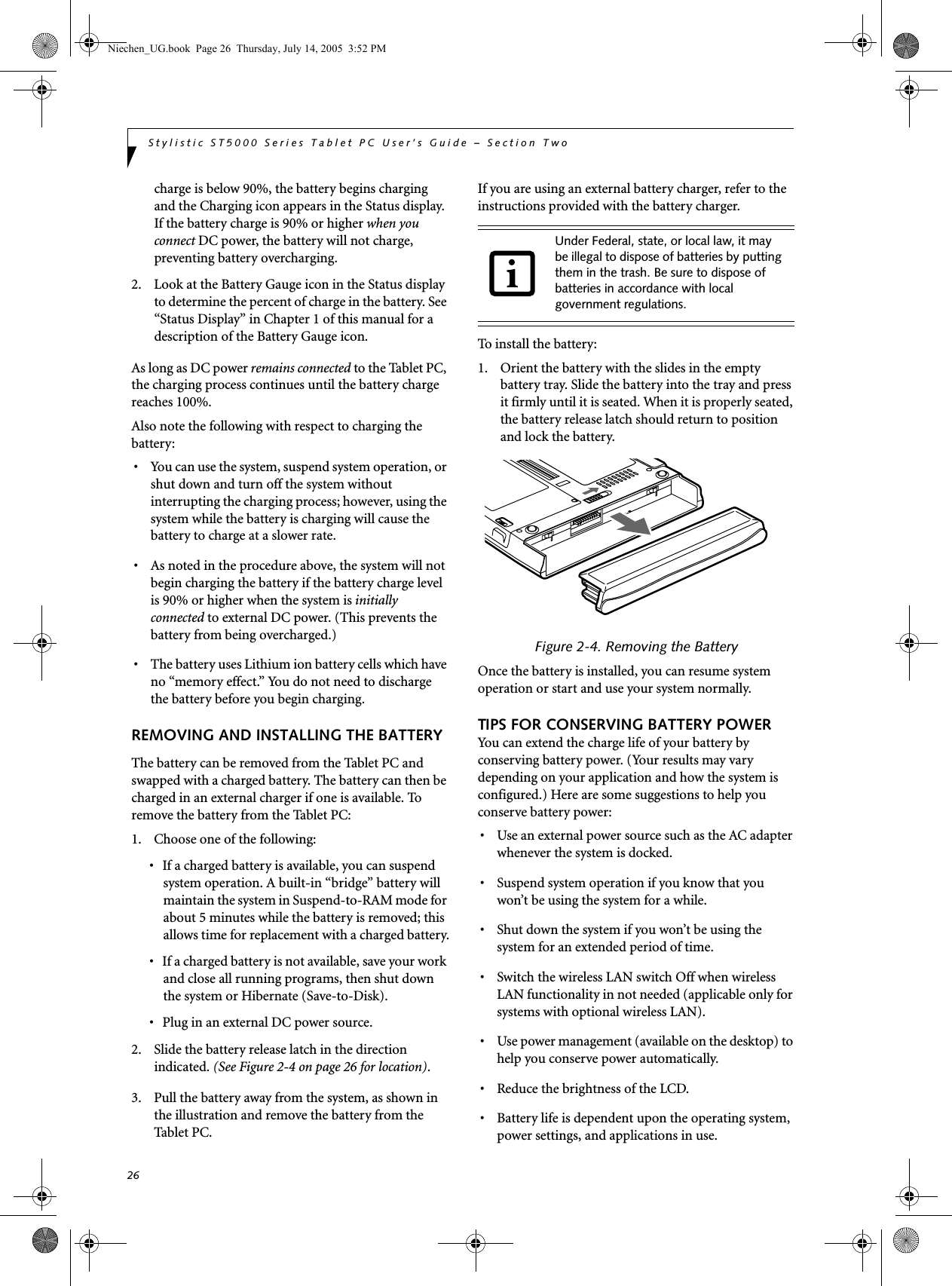
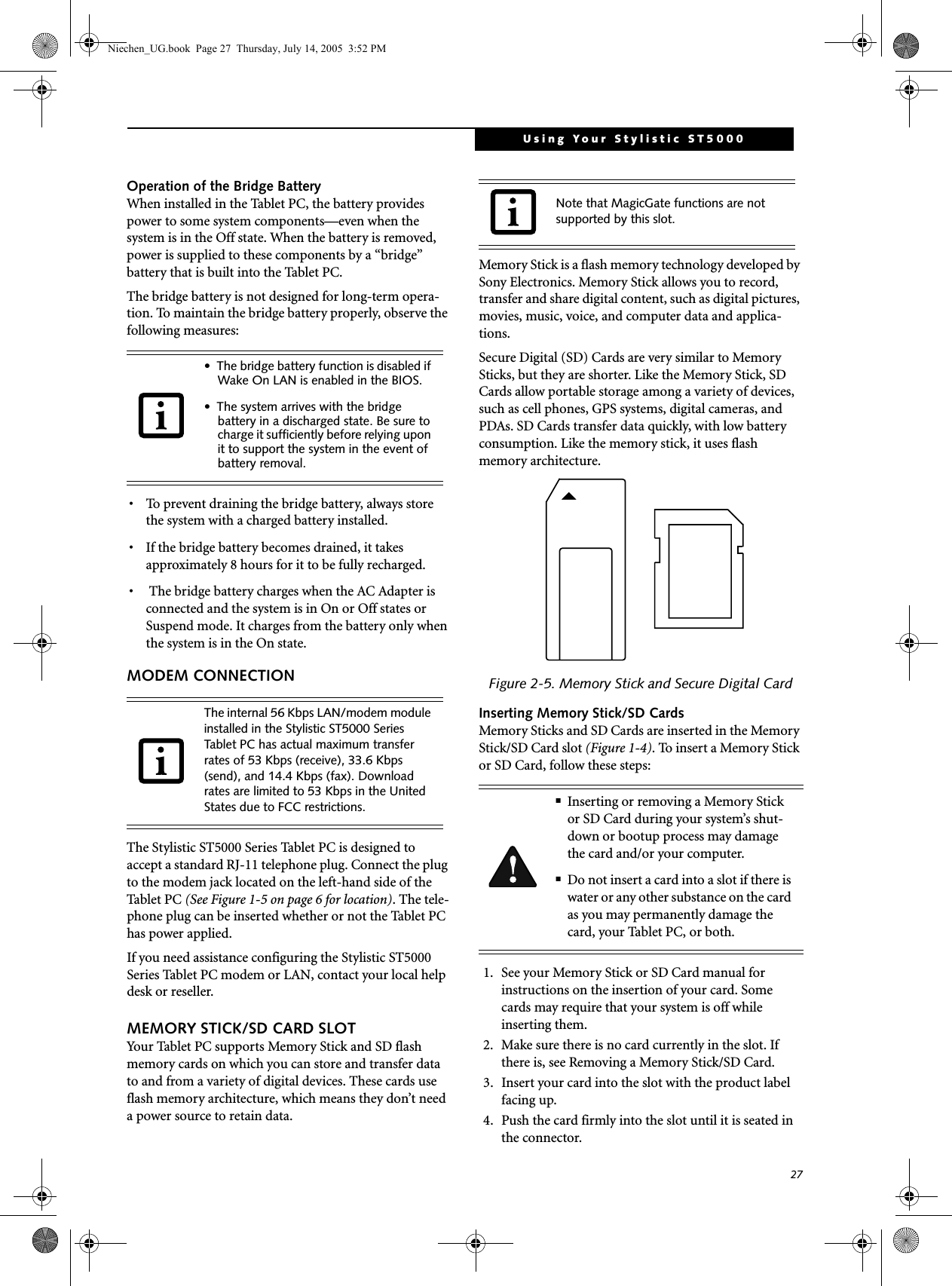
![28Stylistic ST5000 Series Tablet PC User’s Guide – Section TwoRemoving A Memory Stick/SD CardTo remove a Memory Stick/SD Card, follow these steps:Push the Memory Stick or SD Card in until it unlatches. It will then eject from the slot for removalPC CARD SLOTThe Stylistic ST5000 Series Tablet PC Card slot allows you to insert a Type I or Type II PCMCIA Card. Inserting a PC CardTo insert a PC card, position the side with the arrow facing up (i.e., when looking at the tablet’s display side, the arrow on the card should be visible.) Slide the card into the PC Card slot, and press it firmly to ensure proper seating. (See Figure 2-6 for location)If you need assistance inserting a PC Card in the Stylistic ST5000 Series Tablet PC, contact your corporate help desk or reseller.Figure 2-6. Inserting a PC CardRemoving a PC CardTo remove a PC Card, first click the Safely Remove Hardware icon in the system tray in the bottom right-hand corner of the display. Select PC Card from the list, and click [Stop]. Press the PC Card eject button so that it pops out. Once the button has popped out, press it firmly to eject the card. (See Figure 2-7 for location)Figure 2-7. Removing a PC CardREMOVING AND INSTALLING MEMORY MODULESThere are two DIMM slots in your Tablet PC. 256 MB, 512 MB, and 1 GB modules are available, so you can install a combination of up to 2 GB in the system.Installing a Memory ModuleTo install a DIMM module in the Tablet PC: 1. Ensure that the Tablet PC is off. To do so, carry out the Shut Down command in the Start menu. (Do not attempt to remove or install a DIMM module when the system is in Suspend mode or running.) 2. Remove the two screws from the cover plate on the back of the Tablet PC and remove the cover plate as shown in Figure 2-8.Figure 2-8. Accessing the Memory Slot3. Insert the DIMM module in the socket at an angle and push it down until it locks into place as shown in Figure 2-9. Note that the DIMM module is keyed to prevent it from being inserted backwards.Figure 2-9. Installing a DIMM ModuleSee your Memory Stick or SD Card manual for specific instructions on the removal of your card. Some cards may require your computer to be in Suspend Mode or Off while removing them. DIMM replacement should be performed at a static-free workstation. Do not touch connector pins, circuit boards, or other circuit components on the drive or Tablet PC. Electrostatic discharge caused by doing so can damage sensitive components.Niechen_UG.book Page 28 Thursday, July 14, 2005 3:52 PM](https://usermanual.wiki/Fujitsu-Client-Computing/WB0043.App-I1-user-manual-part-1/User-Guide-697892-Page-39.png)
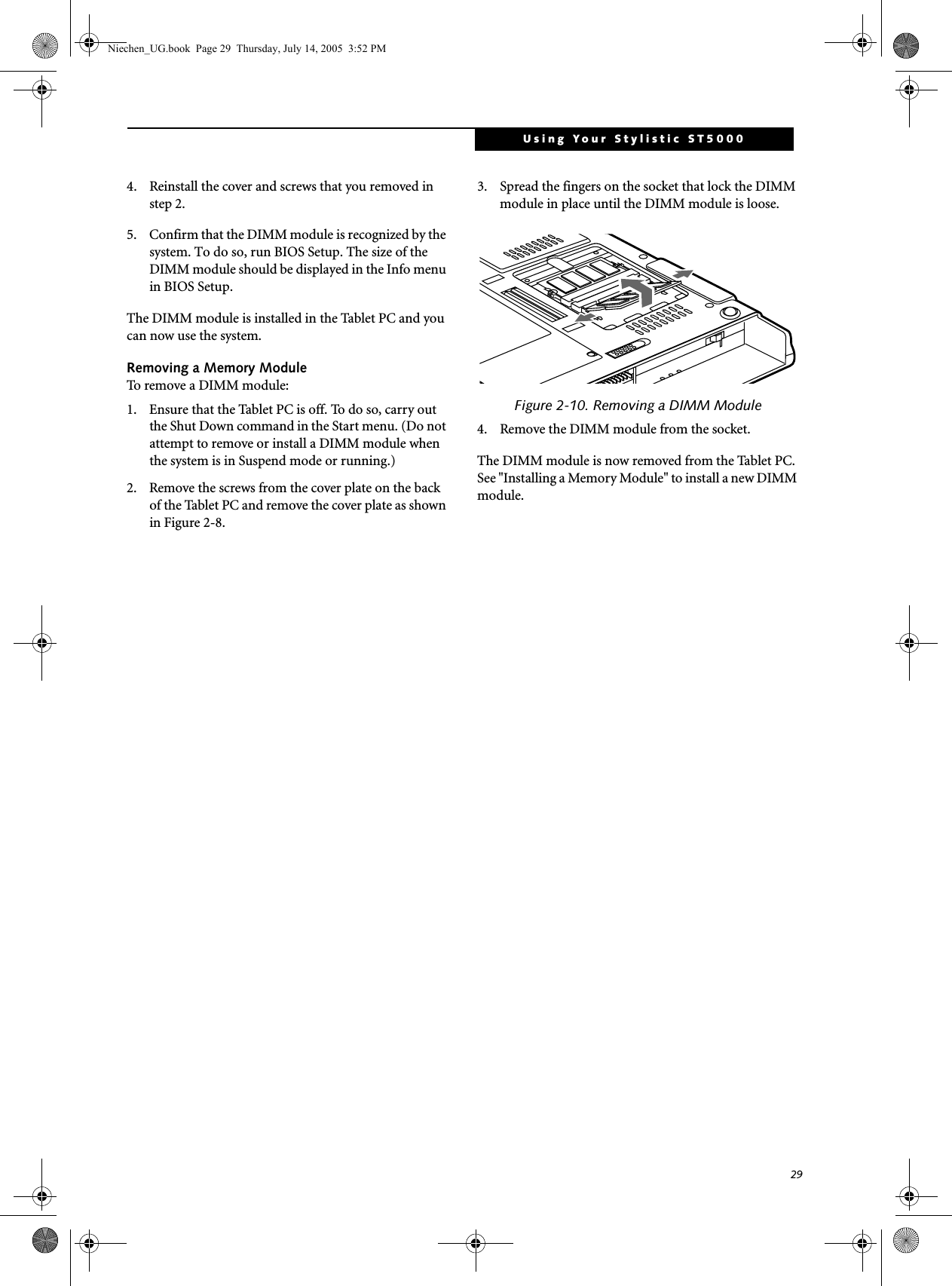
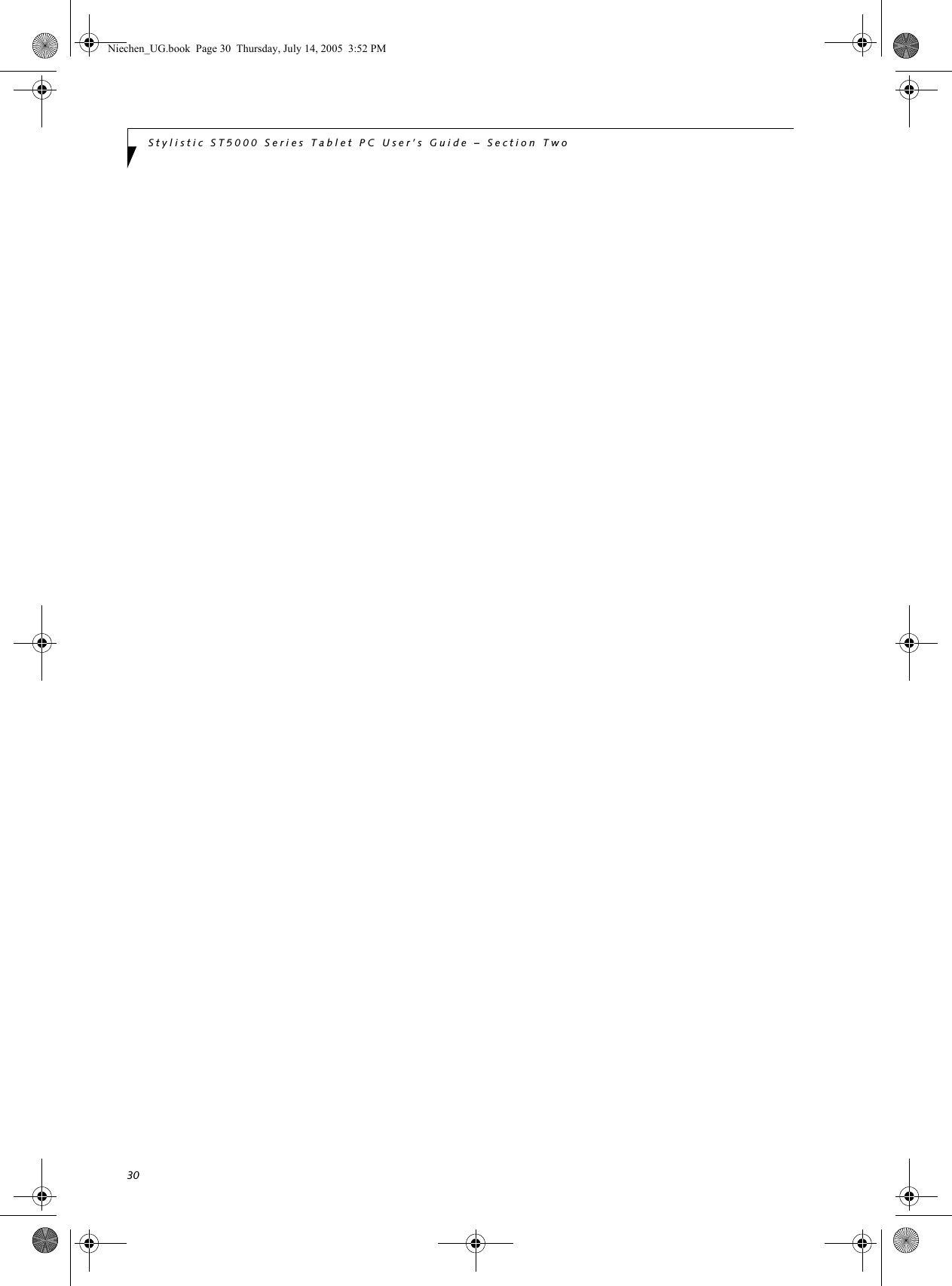
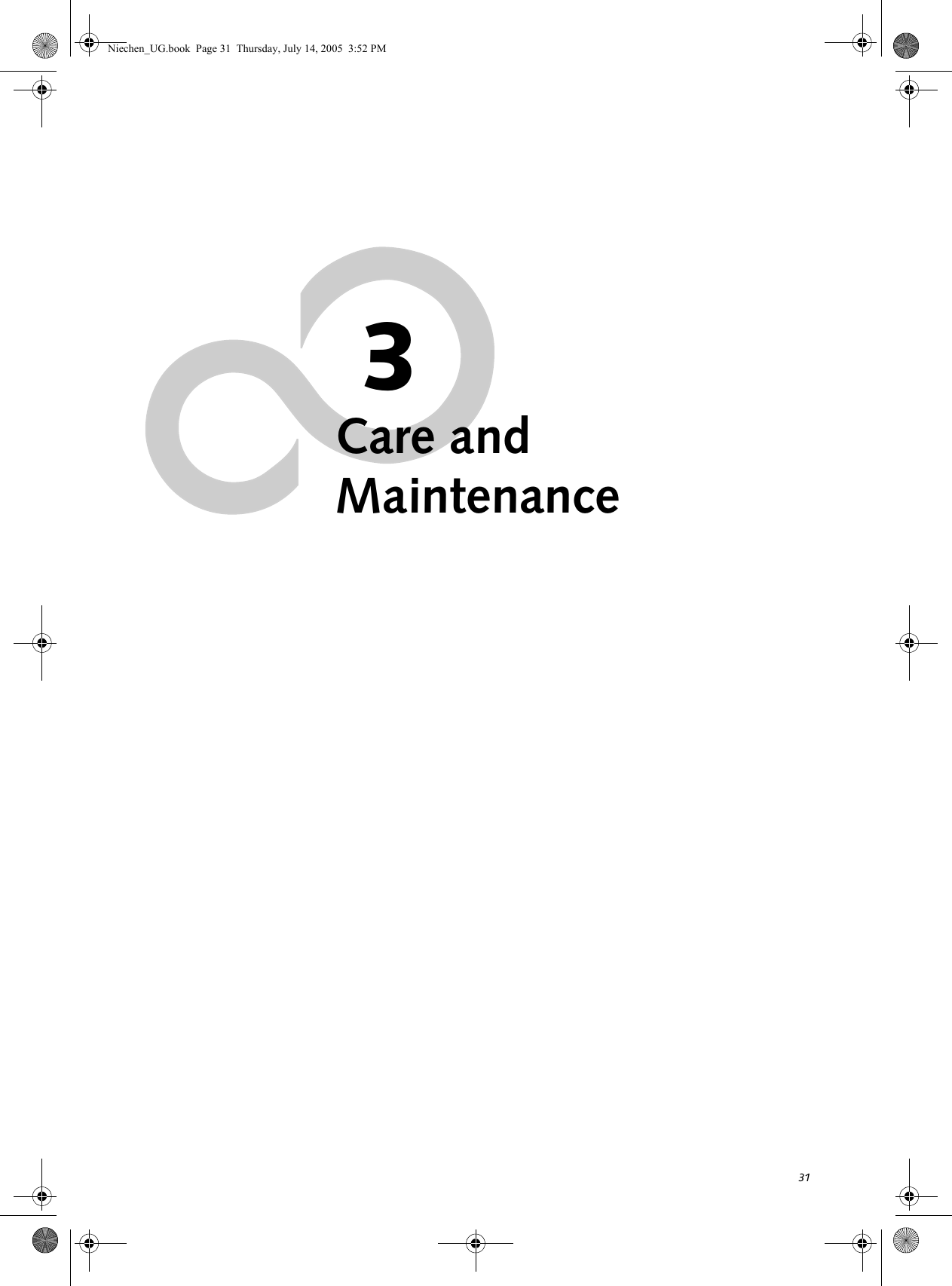
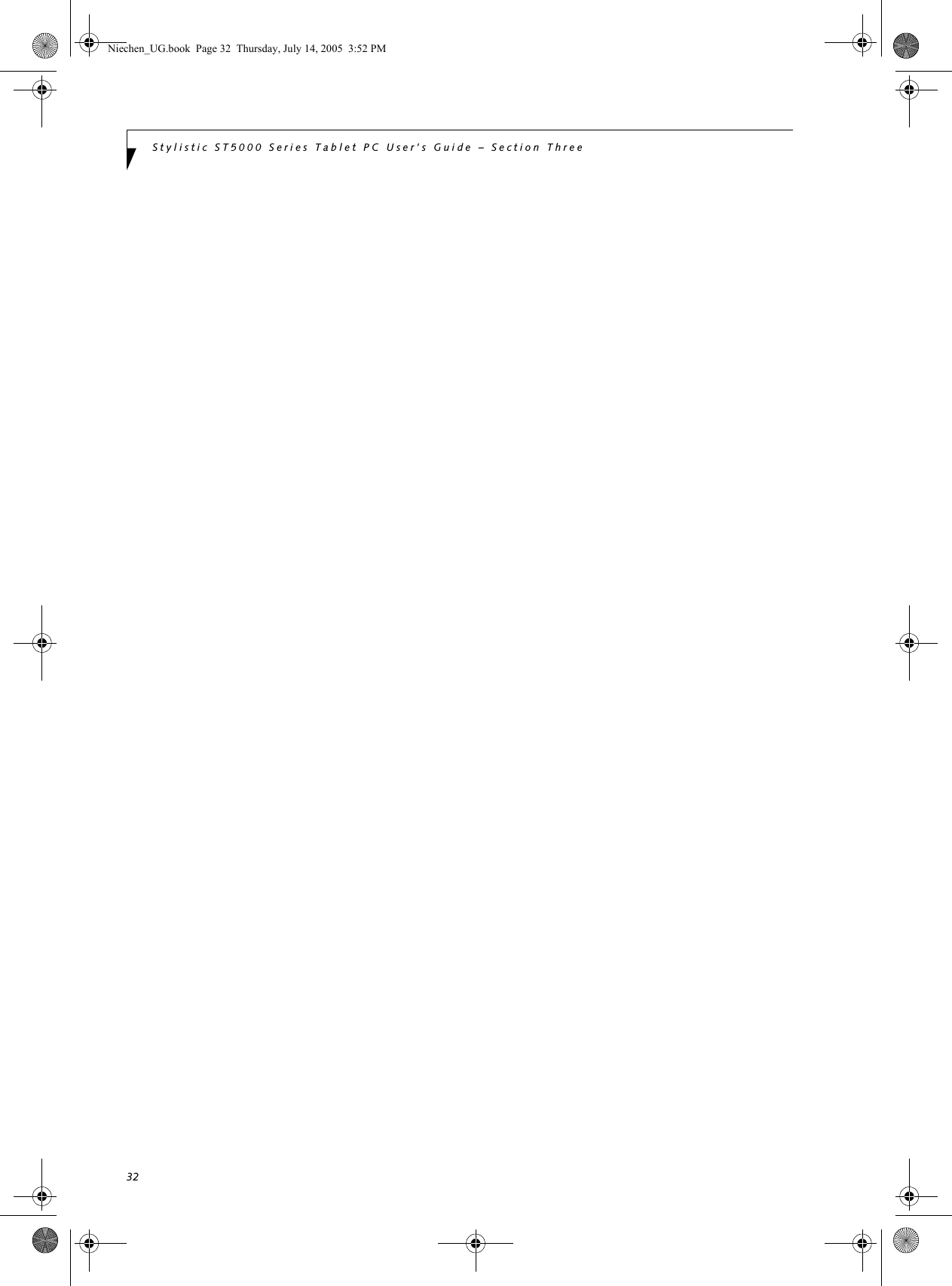
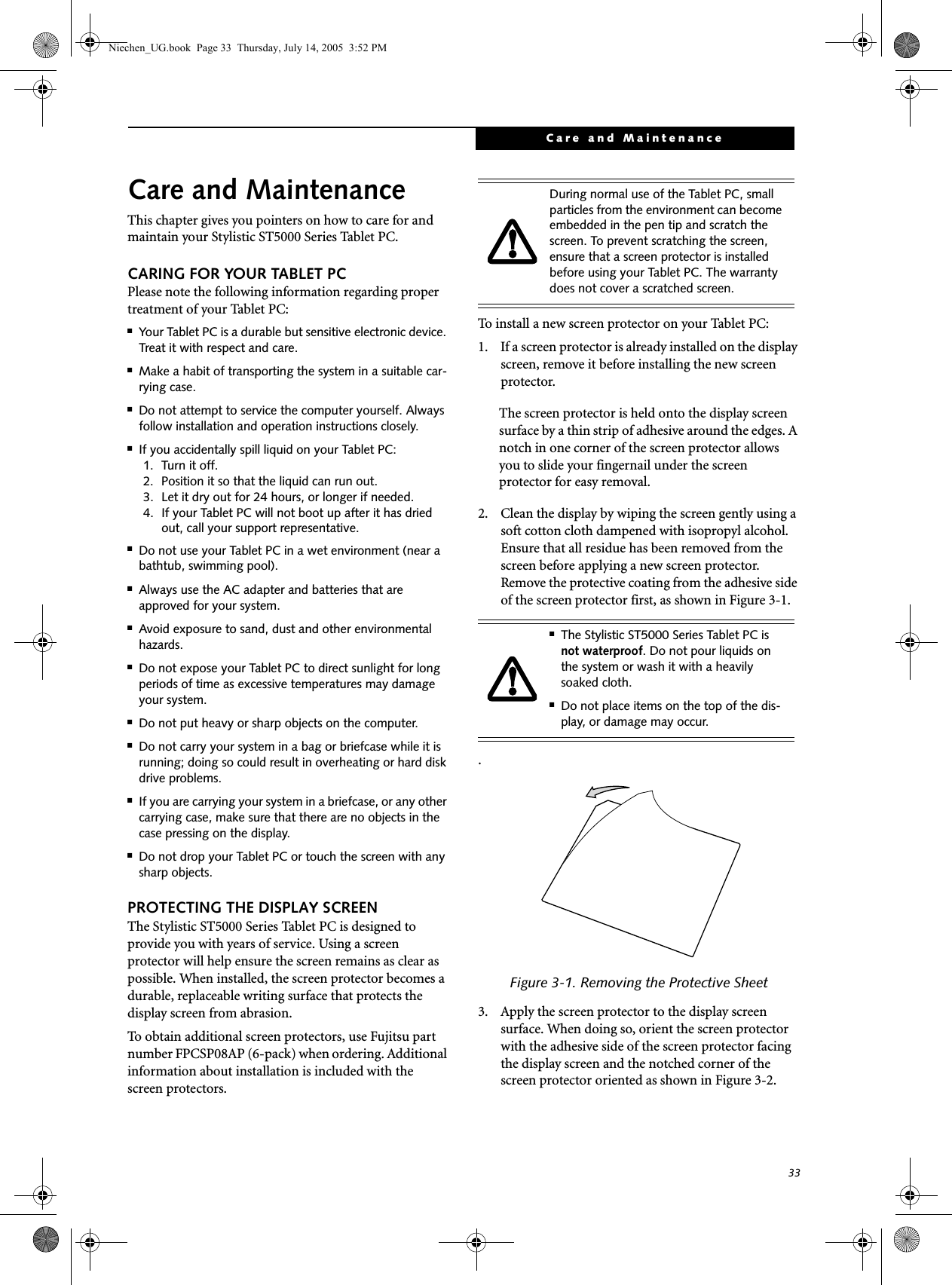
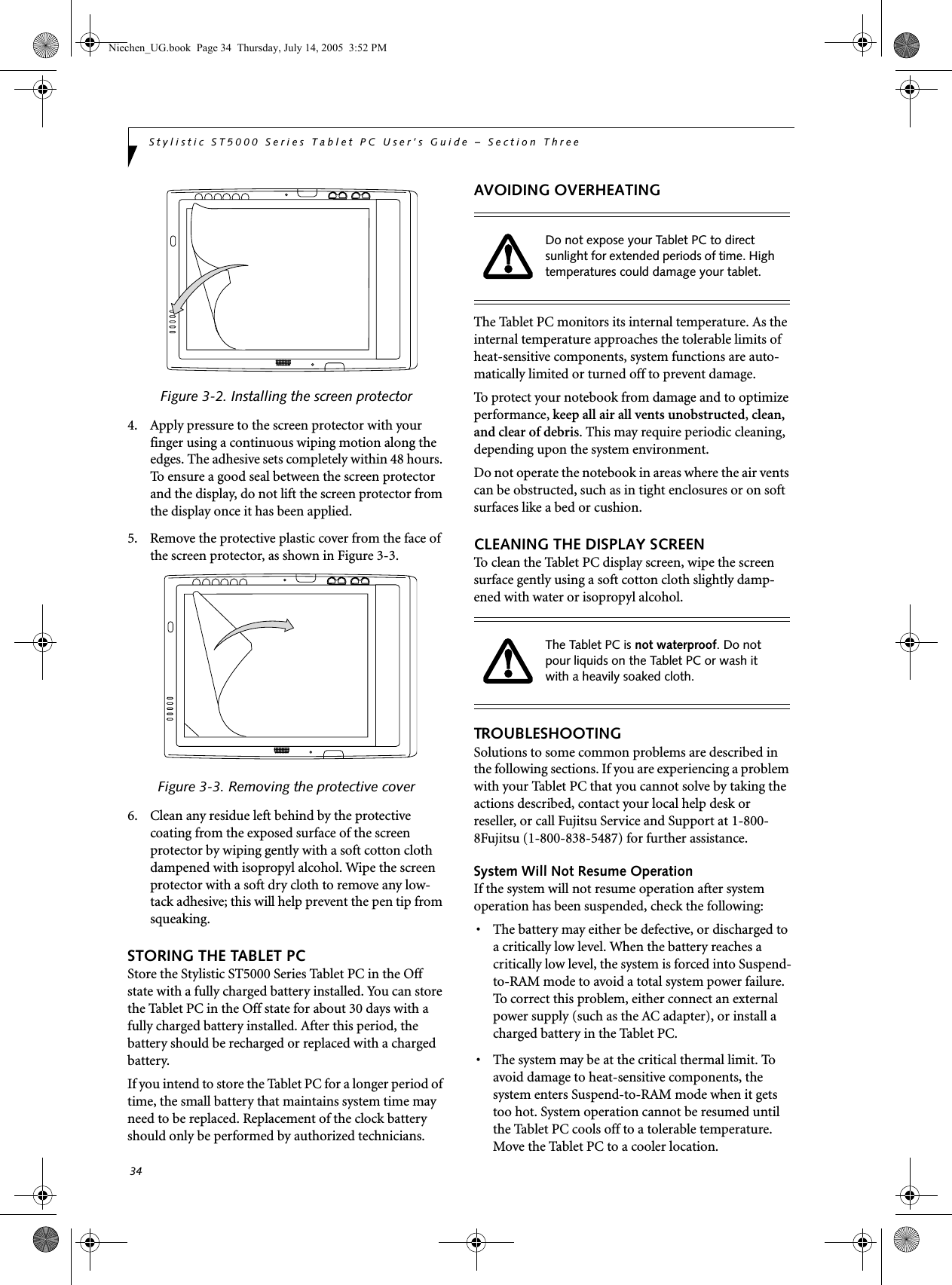
![35Care and MaintenanceDisplay Screen Blank or Difficult to ReadIf the display screen on your Tablet PC appears blank or is unreadable, confirm that the system is running (the Power icon is displayed continuously on the Status display), and check the following: • The system brightness may be set too low, causing the screen to appear too dark. To change system brightness, press the Fn button twice to open the Fujitsu menu. Brightness can be adjusted from the menu.• The video timeout may have expired. Tap on the display screen to reactivate the display. Note that this is a normal, power-saving feature. Cursor Is Not Tracking PenIf the cursor on the screen appears to be misaligned with the pen or is not accurately tracking the pen, calibrate the pen. See “Calibrating the Pen” on page 25 for more infor-mation. Infrared Data Transfer Is Not WorkingIf you are experiencing problems transferring data over the system’s infrared interface, note the following:• Can the IrDA port on the Tablet PC “see” the IrDA port on the other device? A direct line-of-sight path must exist between the IrDA port on the Tablet PC and the IrDA port on the other device. • The distance between the two devices must not be more than 3 feet.• The viewing angle from the IrDA port on the Tablet PC must not be more than 15 degrees from a center line between the IrDA port on the Tablet PC and the IrDA port on the other device. • The device with which you are trying to communicate must be compliant with the IrDA Standard Revision 1.1 (or 1.0). • It may be necessary for both computers to be using the same network connection protocols.Tablet PC is Not Responding to the PenIf the Tablet PC does not respond to the pen, connect an external keyboard to the system to see if it responds to keyboard commands. If the system doesn’t respond to a keyboard, the application or system may have crashed, and it may be necessary to reboot the system. If the system responds to a keyboard but not to a pen, contact your local help desk or reseller, or call Fujitsu Service and Support at 1-800-8Fujitsu (1-800-838-5487) for further assistance.Speaker/Headphone Volume Too LowIf the audio volume on your Tablet PC speaker or external headphones is too low, check the following: • Ensure the speaker (or headphone output if using headphones) is enabled. To do so, open the Control Panel and double-click on the Sounds and Audio Devices icon. Select the proper tab, and increase the volume using the slider bar. (If you aren’t getting any sound, uncheck the Mute box if it is checked.) • Press the Fn button twice to open the Fujitsu menu. Volume can be adjusted from the menu.• Ensure the mute box in the system volume control (accessible from the system tray) is not set.• Ensure any volume control in your audio software is set to an audible level. Configuring Peripheral InterfacesCertain peripheral devices can be disabled during the BIOS Setup. If the peripheral interface you want to use does not appear to be working with your peripheral device, ensure that it is enabled in the BIOS. Contact your local help desk or reseller, or call Fujitsu Service and Support at 1-800-8Fujitsu (1-800-838-5487) if you need assistance using BIOS Setup.RESTORING THE PRE-INSTALLED SOFTWAREThe Drivers and Applications Restore (DAR) DVD contains sets of device drivers and Fujitsu utilities (in specific directories) that are unique to your computer configuration for use as documented below.Re-Installing Individual Drivers and Applications The Drivers and Applications CD can be used to selectively re-install drivers and/or applications that may have been un-installed or corrupted. To re-install drivers and/or applications:1. Boot up the system and insert the DAR CD after Windows has started. A Fujitsu Installer screen is displayed after the CD is inserted.2. After reading the License Agreement, click [I agree].If you have access to the internet, visit the Fujitsu Support web site at: http://www.computers.us.fujitsu.com/support to check for the most current information, drivers and hints on how to perform recovery and system updates.There may be certain free third-party applications pre-installed on your system that are not on the DAR CD. The latest versions of the applications can be downloaded from the third-party’s website.Niechen_UG.book Page 35 Thursday, July 14, 2005 3:52 PM](https://usermanual.wiki/Fujitsu-Client-Computing/WB0043.App-I1-user-manual-part-1/User-Guide-697892-Page-46.png)
![36Stylistic ST5000 Series Tablet PC User’s Guide – Section Three3. A window will appear containing a list of applica-tions, drivers, and utilities that you can install from the Drivers and Applications CD.4. In the list, check off all the components you want to install. If you want to install all components, click [Select All]. Clicking [Select All] will select all of the blue-coded components; you must select grey and green components separately.5. Once you have selected the components you wish to install, click [Install Selected Subsystems]; the components will be installed.6. After the components are installed, click [OK], then click [Yes] when asked if you want to reboot the system. RESTORING THE FACTORY IMAGEThe Restore Disc that came with your system contains two utilities:■The Recovery utility allows you to restore the original contents of the C: drive.■The Hard Disk Data Delete utility on this disc is used to delete all data on your hard disk and prevent it from being reused. Do not use the Hard Disk Data Delete utility unless you are absolutely certain that you want to erase your entire hard disk, including all partitions.BOOT Priority ChangeBefore restoring an image, you must first verify that your system is set up to boot from the DVD drive. To verify/change the boot-up priority (rather than booting-up from the hard drive or an external floppy disk drive), perform the following steps:1. Start your system and press the [F2] key when the Fujitsu logo appears. You will enter the BIOS Setup Utility.2. Using the arrow keys, go to the Boot menu.3. Arrow down to the Boot Device Priority submenu. Press [Enter].4. If “Optical Media Drive” or “CD-ROM Drive” is not at the top of the list, arrow down to the drive in the list, and press the space bar (or the + key) to move it to the top of the list. (The system attempts to boot from the devices in the order in which they are listed.). Note that the BIOS for some systems will indicate “CD-ROM Drive”, even when a DVD drive is connected.5. If you have an external DVD drive connected, proceed to the next step; otherwise, proceed to step 7.6. If you have an external DVD drive connected:• Select the Advanced menu in the BIOS window.• Scroll down to the USB Features submenu and press the Enter key to open it.• If Legacy USB Support is disabled, press the space bar to enable it.• Scroll down to SCSI SubClass Support and press the space bar to enable it. 7. Press [F10], then click on [Yes] to exit the BIOS Setup Utility and return to the boot process.After you have changed the boot priority, you can restore a backup image when you are booting up.Procedure1. Turn on the power to your system.2. Ensure that you have a device that can read DVDs either installed in your system or attached exter-nally to it.3. Insert the Restore Disc into the drive tray.4. Reboot your system.5. After the system reboots, follow the instructions that appear to either restore your system image or erase all data from your hard disk.The components listed are color-coded in terms of their install status. Blue indicates that the component can be installed. Green indicates that the component needs to be installed separately. Grey indicates a component that is already installed; grey items can be reinstalled, but prior to installation you will receive a reminder that the component is already installed. The Restore Disc only restores the primary hard disk drive. If you have an optional second hard disk drive installed, it will not be restored using these utilities.• The use of this disc requires that you have a device capable of reading DVDs attached to your system. If you do not have a built-in DVD player, you will need to attach an external player. For more information on available external devices, visit our Web site at: us.fujitsu.com/computers. • This disc can only be used with the system with which it was purchased.Niechen_UG.book Page 36 Thursday, July 14, 2005 3:52 PM](https://usermanual.wiki/Fujitsu-Client-Computing/WB0043.App-I1-user-manual-part-1/User-Guide-697892-Page-47.png)
![37Care and MaintenanceAUTOMATICALLY DOWNLOADING DRIVER UPDATESYour system has a convenient tool called the Fujitsu Driver Update (FDU) utility. With FDU, you can choose to automatically or manually go to the Fujitsu site to check for new updates for your system.The FDU icon should appear in the system tray at the bottom right of your screen (roll the cursor over the icons to find the correct one). If the FDU icon does not appear in the system tray, it can be started by going to [Start] -> All Programs, and clicking on Fujitsu Driver Update; this will create the icon automatically.To invoke the FDU menu, right-click on the FDU icon. The menu contains the following items:■Check for updates nowAllows for manual driver update search. The first time it is used, you are prompted to agree to a user agree-ment. After clicking on the icon, the FDU automati-cally connects with the Fujitsu site to check for updates and downloads them. While downloading, the icon has a red bar through it, indicating that it cannot be used while the download is in process. When the update is complete, a message appears informing you of the fact.■Enable Automatic Update NotificationsAutomatically searches for new updates on a regular basis (approximately every 3 days).■Show update historyBrings up a screen that displays a history of updates that have been made via the FDU.■About Fujitsu Driver UpdateDisplays the FDU version number and copyright information■Fujitsu Driver Update ReadmeDisplays the FDU readme.Niechen_UG.book Page 37 Thursday, July 14, 2005 3:52 PM](https://usermanual.wiki/Fujitsu-Client-Computing/WB0043.App-I1-user-manual-part-1/User-Guide-697892-Page-48.png)
